FEATURING:
B.L.A.C.K. Outreach SJ Creative Ambassadors 2023















FEATURING:
B.L.A.C.K. Outreach SJ Creative Ambassadors 2023














Fall 2023
Cultivator
Daniel Garcia
Editors
Elizabeth Sullivan, Samantha Peth
Katherine Hypes, Katie Shiver
Virginia Graham, Danae Stahlnecker
David Ngo
Photographers
Alex Knowbody, Leopoldo Macaya
Sannie Celeridad, Miguel Ozuna
Kinley Lindsey, Avni Nijhawan
Stephanie Barajas, Gl-o
Danielle Caryl Robinson
Producer David E. Valdespino Jr.
Writers
Brandon Roos, Esther Young
Nathan Zanon, Johanna Harlow
David Ma, Ethan Gregory Dodge
Tovah Cheng, Shelly Novo
Daniel Arriaga, Troy Ewers
Taran Escobar-Ausman, Justin Ebrahemi
Alyssarhaye Graciano
Interns
Nirvan Vijaykar, Aaliyah Roman
Publisher SVCREATES
An unexpected joy of publishing Content Magazine for 12 years is the establishment of some traditions. At 12 years, I am taking the liberty of declaring reoccurring themes and features as “traditions.” One of these developing traditions is featuring the Creative Ambassadors of the City of San Jose’s Office of Cultural Affairs. Since 2019, the Office of Cultural Affairs has commissioned local artists to develop projects, works, and programs to spread art in the San Jose Community.
The city has supported Content in various ways since our start. The city being the most significant supporter of the arts in the South Bay and San Jose being my hometown and where our headquarters are, it makes sense to feature the artists they are also looking to develop. What is unique this year is that we have already featured most of this year’s ambassadors in previous issues. But don’t
worry; this is not a repeat or a rerun.
For example, we featured Bertrand Patron Paule as a solo artist in issue 4.5, “Ritual,” in 2012 (our first year), and Suhita Shirodkar in issue 6.2, “Device,” in 2014, during times that they were both emerging and connecting with the community. Now, we are pleased to feature them—as they are arriving at an established point in their careers—as Creative Ambassadors. Also finding a niche in which to channel artistic talents and serve the community, are James Mertke and Yaya Bautista, who we are excited to present in this issue. We hope to see them in the future as they establish themselves as creatives. Getting back to traditions, an aspect of my vision for Content goes unnoticed. We like to place emerging artists alongside established artists to build networks and career opportunities. Even though some of these
“established” artists have great followings within their fields, we desire to create a mix of disciplines and genres to expand their audiences and build appreciation from other creatives and among our readers. Thus, having tattoo legend Abraham Ortega and hard-working muralist Paul J. Gonzalez coupled with emerging poet Elodia Benitez is an intentional strategy to expose various communities to each other. Ultimately, the one tradition that I want Content to be known and recognized for is that we help build the creative community by profiling local artists and developing a community that supports and values the creatives of all genres.
Thank you, Daniel Garcia THE CULTIVATOR
San José Museum of Art Curators | Pantea Karimi | Paul J. Gonzalez | Weezmatic
To participate in CONTENT MAGAZINE: daniel@content-magazine.com Membership & sponsorship information available by contacting david@content-magazine.com IN THIS ISSUE


PROFILES 15.4
Fall 2023 San Jose, California
8 B.L.A.C.K. Outreach, Lou Dimes & Pamela Emanuel
12 Developer, Michael Messinger
ART & DESIGN
16 Tattoo Artist, Abraham Ortega
20 San José Museum of Art Curators, Lauren Schell Dickens, Nidhi Gandhi, & Juan Omar Rodriguez
26 Artist and Designer, Paul J. Gonzalez
30 Multidisciplinary Artist, Pantea Karimi
36 Artist, James Mertke
42 San Jose Creative Ambassadors, Yoon Chung Han, SJ Storyboard, Suhita Shirodkar, & Together We Create 52 Filmmaker, May Yam
STYLE
56 Meraki by Yaya Fashion Design, Yaya Bautista
WORDS
60 Poet & Storyteller, Yosimar Reyes
64 Poet, Elodia Esperanza Benitez
MUSIC
68 DJ, Weezmatic, Aaron Aquino
72 Album Picks, Needle to the Groove
74 Contributors
All materials in CONTENT MAGAZINE are protected by United States copyright law and may not be reproduced, distributed, transmitted, displayed, published, broadcast, or modified in any way without the prior written consent of Silicon Valley Creates, or in the case of third party materials, the owner of that content. You may not alter or remove any trademark, copyright or other notice from copies of this content. For further information, or to participate in the production or distribution, please contact us at editor@content-magazine.com


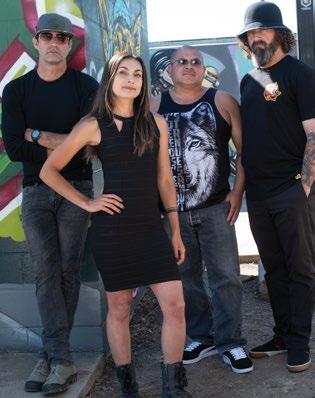

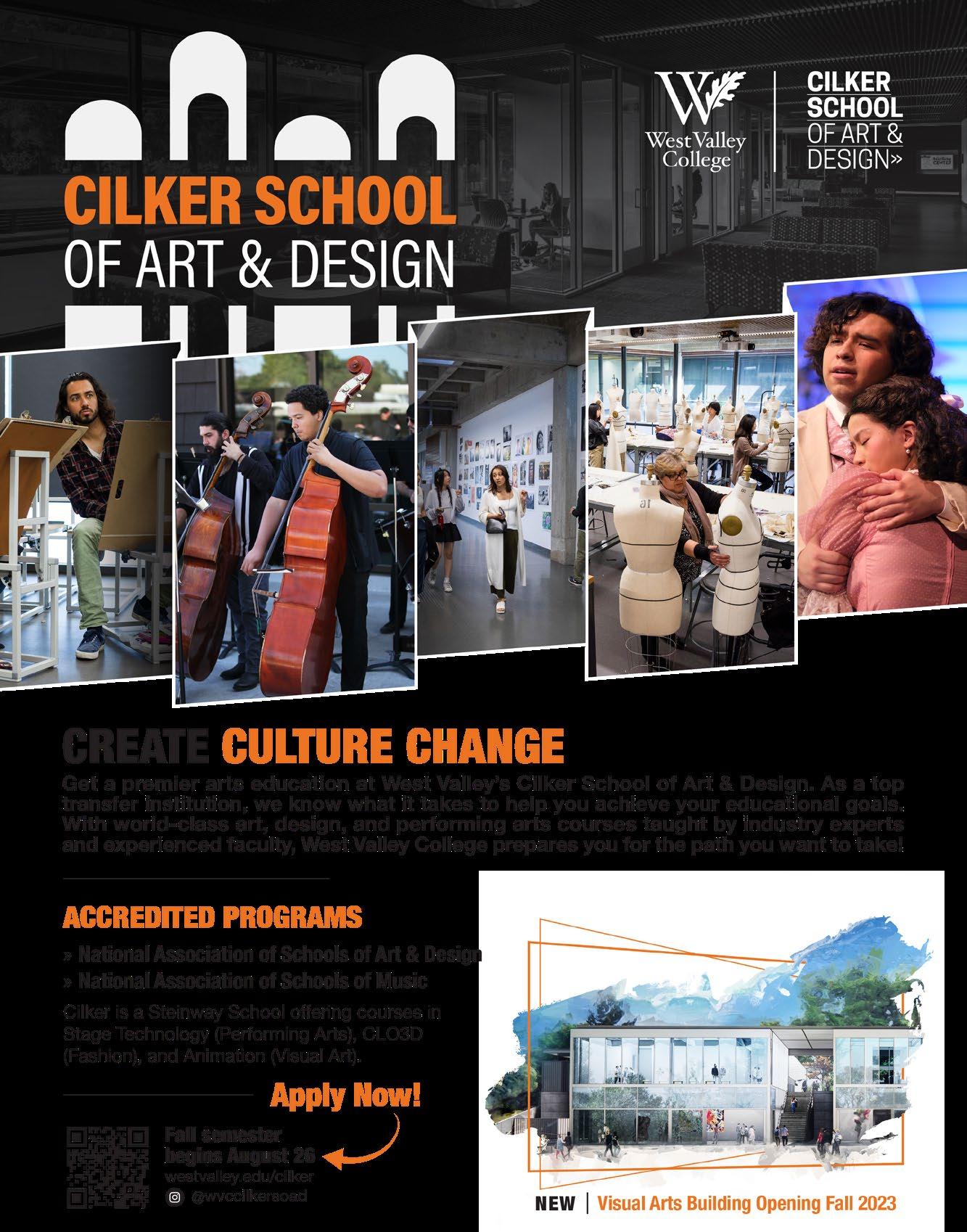
Led by a motto emphasizing economic stability for all people, B.L.A.C.K. Outreach pushes against San Jose’s wealth disparity, ultimately building a stronger Black community.
B.L.A.C.K. OUTREACH SAN JOSE , established in 2020 during the summer of protests for Black lives, may be one of the youngest organizations of many in the South Bay working to provide mutual aid and self-support to unhoused and marginalized people. It is also—in the landscape of social activists—informed by the most systemimpacted experience.
As president and vice president of B.L.A.C.K. Outreach, Lou Dimes and Pamela Emanuel have navigated the foster care and carceral systems that further punish those in unsteady living conditions. It’s these personal experiences that push them to invest deeply in the improvement of these systems and the healing of the families affected by them.
By the time Pamela was a sophomore in high school, she had already seen two of her brothers get locked up. One was placed in juvenile detention for running away from his foster home. The other was incarcerated for a murder committed by someone who had borrowed his phone. As she sat in the trial, watching the judge sentence her brother to 25 years to life for a crime he didn’t commit, she committed herself to learning the judicial system from the inside out. At first, justice seemed in reach. Talking to her brother’s lawyer, Pamela met a public defender working specifically to charge police for violent acts. She learned about the passing of SB 1437, a bill that changed the terminology of who
is considered a murderer, posing the possibility that her brother could face a different charge and be released sooner. “But then I learned how much power the judge holds,” she shares. “Even with this bill, a judge can [rule] that this is not constitutional.”
Later, Pamela’s mother was also incarcerated. At 19, Pamela became head of her household, raising her brother and managing her mother’s belongings while fighting for her release.
The day that George Floyd was killed, Pamela was at a protest in Sacramento, advocating on behalf of her mom and brothers for better living conditions in the Sacramento County jails. Better living conditions meant providing her mom, who was immunocompromised, with a mask during the pandemic. It meant serving her mom food that was not infested by maggots. “When you see it done to your family, it puts something inside of you. No one can try to convince me that I should not be talking about this.” At the same time, “I can’t do anything that’s going to incriminate myself.”
Fully cognizant of her own freedom and safety allowing her to keep fighting for her family, Pamela is mindful of the experiences that new members


 Lou Dimes
Lou Dimes
of B.L.A.C.K. Outreach carry with them. The organization grew out of a group of protesters, but as they were voted into their official roles, both Lou and Pamela agreed that becoming a Black Lives Matter chapter wasn’t the direction they needed to go to effectively serve their community in San Jose.
Like all of B.L.A.C.K. Outreach’s programs, the first one they developed was driven by intent, cultivated by lived experience. For Lou, it was essential that the organization did more than protest. “We wanted to mold it into something distinctly for San Jose that addresses these things on a multi-prong level,” he explains. One need he wanted to address immediately was food insecurity. “We’re in a super-wealthy city and county, and homeless people in Detroit eat way better than when I was homeless out here,” Lou says.
Feed the Block, their flagship program, stands apart from most food distribution programs in its unique brunch menu—pancakes with eggs and sausages, cooked with kale, tomato, and onion. “We used to always eat brunch growing up, and that was a little pleasure we would still try to give ourselves, even when we were going through rough times,” Lou explains. “We aim to give that to people who traditionally can’t get it.”
The memory and the insistence of joy carried him through the disruptions of his young adult
years. Prompted to share his story, Lou begins and ends talking about his mother, a retired historian who specialized in politics and voting rights of ancient peoples on the Italian peninsula. “Growing up around her and in her classroom, I was always learning about revolution and social movements,” he shares. “I would watch her. If something was wrong, my mom always said something.” Lou grew up knowing what kind of person his mom was trying to raise and who he wanted to be.
Originally from Detroit, he followed his mom to different universities around the country where she taught. They lived in Italy for four years. Upon their return to the states, Lou’s grandmother suffered a stroke, and he and his mother took care of her together. The year was 2008, during the economic crash. “It was really difficult for my mom to find another teaching job here, stateside,” Lou remembers. “She wasn’t able to work. Her health deteriorated as well.”
By the time Lou turned 14, he and his mom were transient. They squatted in different family members’ homes, stayed in their car and at different hotels. He remembers his lung collapsed that year. But most vividly, he recalls the day child protective services came to his school and declared him a ward of the state. “That’s when I had my first serious personal interaction with the system.”

“When you see it done to your family, it puts something inside of you. No one can try to convince me that I should not be talking about this.” -Pamela Emanuel
“That was the first time I realized, it doesn’t matter. Even if you don’t do anything, haven’t committed a crime, you can still end up in jail.” -Lou Dimes

They took him to the police station and kept him in a holding room. The CPS agent failed to place him in a foster home, so she placed him in a juvenile center—what was supposed to be a couple of days lasted months. “That was the first time I realized, it doesn’t matter. Even if you don’t do anything, haven’t committed a crime, you can still end up in jail. I hadn’t done anything,” Lou observes, “I was just homeless.”
Looking back, Lou sees how decisions were made for him by a system and notes the points where certain resources and access to an aware community could have helped him advocate for himself. When CPS moved him into “supervised independent living,” a program meant to transition foster kids who had aged out, he successfully graduated from high school and applied to the Art Institute of Chicago. Lou was accepted with a $50,000 merit scholarship, but the total tuition deterred him from enrolling. “I was scared to take on debt at that point,” he says, looking back. “Now I’m older, I understand I could have got more support.” But there was little reinforcement in his life to show him how.
One of B.L.A.C.K. Outreach’s programs promotes the value of Black students finding one another and accessing support. The organization partners with schools to implement an app
called Blackbook. “Even if there’s a kid at a high school where they may be the only Black student, instead of putting the pressure on them to create and maintain a BSU (Black Student Union) by themselves, they could just join a network,” Pamela explains. An online version of the app not only connects Black students and teachers but informs them of community events—whether that be organizing or what parties are happening.
Despite the breadth of projects and reliance on volunteers for this young organization, Pamela and Lou remain discerning about its membership. “We have people who may be with us hardcore six months, and then they go off to school somewhere,” Lou explains. As president, he encourages it, but that means the turnover of membership is great. To make an impact, they choose members who are impacted. People who mean well but haven’t shared these experiences don’t realize how it affects everyone in the family.
“I don’t think anyone will ever be fully healed from the things that happen in this society,” Pamela admits. “But by giving them those different types of outlets, they’re actually being heard and loved.” C
Over the course of the past decade, real estate developer Michael Messinger has built an impressive footprint in downtown San Jose—specifically, at the corner of Santa Clara and San Pedro Streets, right at the gateway to San Pedro Square. Part owner of the Farmers Union, Olla Cocina, and San Pedro Social, his most recent endeavor is Blanco Urban Venue, a new event space with a sophisticated, modern vibe and what he describes as a “blank canvas,” a place that can be transformed for nearly any type of gathering (hence the name Blanco).
Messinger set out to create a space where people can do whatever they want, distinguishing the venue from many event spaces where decor is either limited or the natural beauty is the main draw. “Most weddings I’ve gone to are in wineries or out in the country, or, in my day, you got married in hotels. We wanted to create something that was not the typical wedding venue. It’s nice to be married in vineyards, but the new generations want to be a little hip,” he shares.
A San Jose native who started his career as a stockbroker before getting into real estate, Messinger is not one for the spotlight, but his love for building community by creating venues for locals to enjoy together is clear. The Farmers Union was his first attempt to bring a restaurant with a San Francisco feel to downtown, striking a balance between upscale and approachable, with a seasonal and locally-sourced menu. Right next door, Olla Cocina offers a fast casual Mexican menu with plenty of open space for friends to gather over a margarita. The sprawling San Pedro Social offers arcade games, an outside patio, and a downstairs bowling alley, encouraging mingling and playfulness.
Messinger’s face lights up when talking about each location and how they are a part of bringing energy and vitality to the city. “It’s a whole little corner there,” he says. “You get married at Blanco, you get a rehearsal dinner at Farmers, and you get the afterparty at Social.”
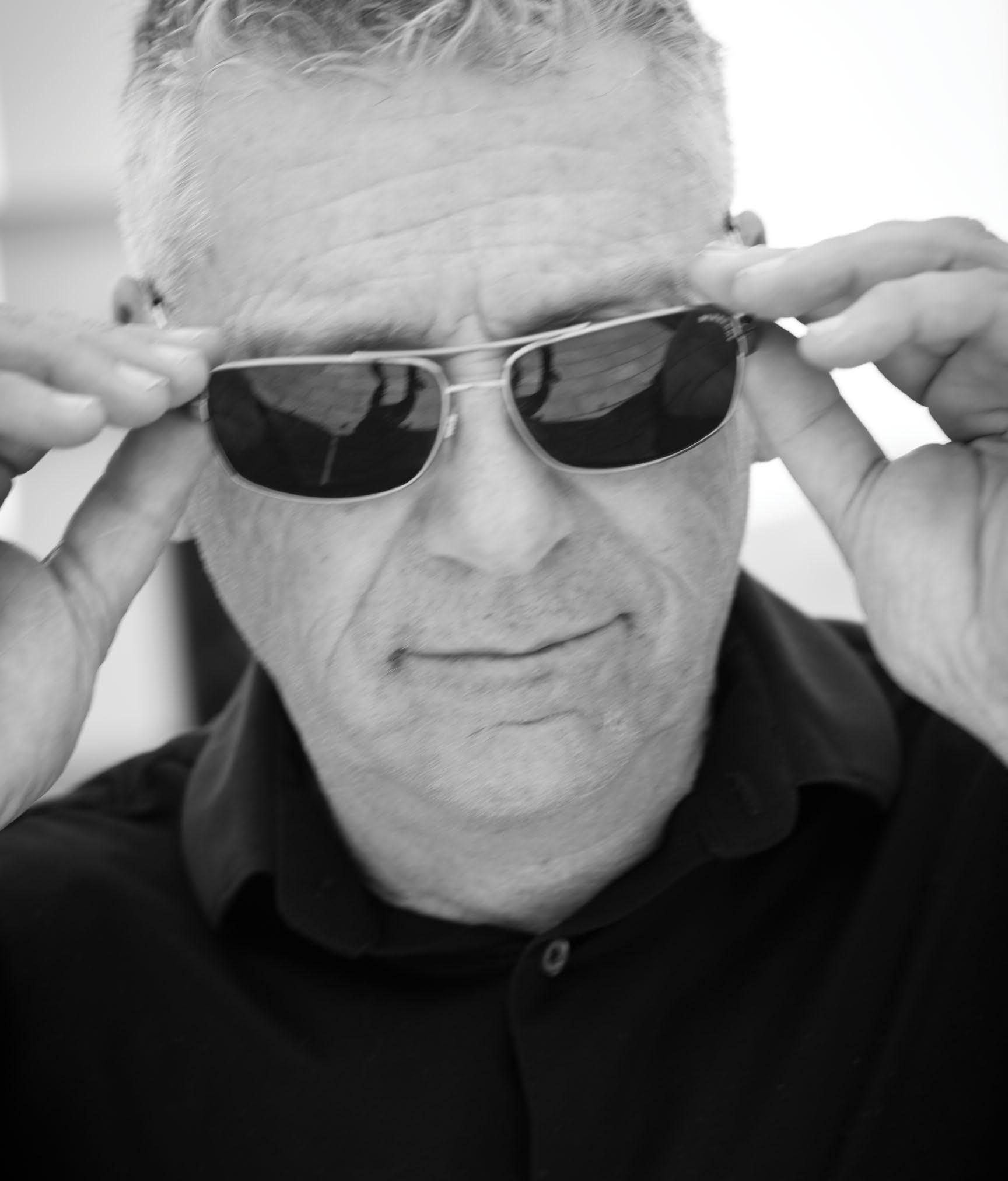
The Farmers Union. Olla Cocina. San Pedro Social. Blanco Urban Venue.

“I like just creating concepts and putting them into spaces so it looks really cool.”
Blanco is a departure from the restaurant/bar concepts of his other San Jose ventures. A three-story building that includes open-air balconies on both the second and third floors, it offers a different kind of event space in the downtown area from what was previously available. Built from the ground up, Blanco’s open architecture creates plenty of room, but with a feel that is both cozy and exciting. Its proximity to a bustling block adds to the energy; the open balconies give wedding and event guests a view of the block, recently closed to vehicle traffic and populated nightly with socializing San Joseans. In turn, the people on the street feed off the fun at Blanco. DJs and dancing greet pedestrians as soon as they walk under the archway that welcomes visitors to San Pedro Square.
People have been very creative with the space—which offers two rooftop decks and a fireplace in the background—like bringing in a lot of colored lights and DJs, adding drapes on the walls and the ceiling, and hanging ivy on the chandeliers. While they offer rentals for any kind of event, from corporate and private parties to seminars to watch parties, the biggest draw has been weddings. “We felt it would work in downtown San Jose—and it definitely has,” he shares.
The space has a lot of quality and character thanks to Messinger’s insistence that it be built high-quality with attention to detail to ensure it lasts. “We hired a bunch of artisans to really handcraft things, like all the railings on the balcony, and the doors are 150-yearold wood. We didn’t spare any expenses on it—hardwood floors, the bathrooms are decked out,” he shares. “It’s quality workmanship. I can’t do it halfway, I guess.”
Part of Messinger’s goal with all these projects has been to help San Jose establish a strong downtown like he sees in many other major cities. Over the decades, San Jose has struggled to have a consistent, walkable, and connected space with the energy of a downtown nightlife. He clearly sees San Pedro Square as that kind of presence, a central hub to the other walkable nearby districts like Little Italy, Fountain Alley, and SoFA.
“The city has definitely had a lot of ups and downs,” he says of his time living and developing in the South Bay. “It’s a bit of a roller coaster ride, and it still is that way. But you know, I bought all my properties based on the best location.” Although there was a downswing in business during the pandemic and a subsequent delay in the development of the Google campus that would have brought significant foot traffic, the neighborhood has been surging back to life.
With properties not only in San Jose but scattered around the Bay Area, Messinger has built a legacy of sorts, but it is also becoming clear that it may be time to wind down. He’s handed many of the business operations off to longtime colleagues and to his son Grant and moved south to Newport Beach with his wife.
“It’s been a lot of work for many, many years, trying to get them all done,” he sighs. “I love creating…Even with the old buildings, they have a lot of character, but they’re [also] kind of a blank palette where you have to start over, redo them from the ground up. I like just creating concepts and putting them into spaces so it looks really cool. I’m doing one last one in Livermore. ‘Hopefully it’s the last one,’…my wife says.” He trails off with a wry chuckle, a hint that perhaps he has said something similar before, and it was not, in fact, the last one. C

“I put together a rig with a Walkman motor, pen, toothbrush, guitar string, and I started tattooing my legs and all the homies in the neighborhood.”
 Written by Ethan Gregory Dodge
Written by Ethan Gregory Dodge
Pencils and sketch pad in hand, a young Abraham Ortega excitedly headed out to a friend’s birthday party. The son and grandson of artists, he was already a passionate sketcher. Consistent encouragement from his mother led him to assume that drawing was the de facto activity for all kids his age and would thus be the primary happening that night. However, as the party progressed, he soon realized that wasn’t the case. “I thought everybody drew because my cousins would draw, my brother would draw,” Ortega says. “Everyone that was in my world as a kid would draw. I thought that’s just what people did.”
Since then, Ortega’s artistic drive took him from childhood drawings of cars and motorcycles to tattooing black and gray Chicano imagery. What once was a teenage hobby has turned into a fruitful career as both a tattooist and shop owner. Abraham Ortega is a staple in both the San Jose and Chicano tattooing communities.
Born in the Garden City in 1974, Ortega was raised on the East Side by proud Chicano parents. “My parents really pushed the whole Chicanismo on me. It helped me be aware of who I am and where we stand as a people,” he says. “That shaped who I am today, especially with my tattooing.” This sentiment is beautifully embodied in a large painting on the wall of his shop. It depicts a “proud Chicana” holding her hands in the shapes of the letters E and S for “East Side.” Behind her the number “1910” looms large. It symbolizes the nineteenth and tenth letters of the alphabet: S and J.
Ortega has a childhood memory of watching his cousin construct a tattoo machine. At the time, he didn’t care much about the craft and was more fascinated by the mechanics of the device. Eventually, as a teenager, he did develop an interest in body art and leveraged the memory to build his own. “I put together a rig with a Walkman motor, pen, toothbrush, guitar string, and I started tattooing my legs and all the homies in the neighborhood,” he says, chuckling. “Everyone knew I could draw so they were all for it.”
Ortega and his friends have routinely experienced discrimination in their everyday lives. “I have been beat up by the cops for no reason,” he says. “I have been arrested for no reason.” As they embraced their ethnic identities with these tattoos, the biases others
“My
parents really pushed the whole Chicanismo on me. It helped me be aware of who I am and where we stand as a people. That shaped who I am today, especially with my tattooing.”



held against them grew. “Back in the 1990s and 2000s, it wasn’t respected,” he says. He remembers people calling the style “cholo shit,” but he strongly disagreed. “I was trying to push it as an art form. It’s beautiful shit. I wasn’t trying to make it gangster. I was just trying to make it cool.”
Within a few years, at the age of 18, Ortega began tattooing professionally in the East Side shop Vision Tattoo. While there, he became a father and began to work other jobs, but in 2000, he returned to the tattooing world and saw his cultural iconography go from socially stigmatizing to mainstream.
The first time a white client asked for a Chicano tattoo, Ortega wasn’t sure how to feel. “I was torn because I thought, ‘This is ours. Why are you getting this when you didn’t earn it?’ ” he says. “But then I realized if I want to push this as an art form, then everybody has to appreciate it and I got to be able to appreciate anybody who wants it.”
Through the 2000s, Ortega was tattooing mostly walk-in clients who wanted many different tattoo styles. But by the end of the decade, he joined Death Before Dishonor Tattoo Studio and was able to see clients by appointment only. This afforded him the opportunity to perfect his Chicano style and build a solid clientele. In 2014, he felt the need for change and began entertaining the idea of opening his own shop.
“I didn’t know where else to go,” he says. “I didn’t want to leave San Jose. This is where my people were, but there wasn’t a shop that I felt I would fit in. There were good shops, but I just felt like they weren’t really my style.” So, in 2016, he took the plunge and opened Blacksuit Tattoo on Second and Santa Clara.
“I feel Blacksuit is an underdog shop. I feel that we don’t politic, we don’t play the game. We’re just here doing our thing, and I think, to this day, people still don’t know who we are or where we are.”
Despite this impression, anyone who walks off the street into Blacksuit will find half a dozen tattooists busily practicing their craft and clients leaving with gorgeous works of art on their bodies. While Ortega may feel like an underdog, there is no denying the legacy he is leaving in the 408. C


(SJMA), founded in 1969 by a group of artists and activists, has long strived to be in touch with the needs of artists and the community. As a leading showcase of modern and contemporary art in the Bay Area, SJMA hosts innovative and compelling exhibitions designed to engage audiences of varying ages and backgrounds. Despite traditional narratives that frame art museums as leisure places for the elite, they aim to serve as community access points into a world that examines contemporary social concepts through the eyes of human experience.
Living in the blank space between the pages of artist and audience, curation facilitates, interprets, and amplifies an artist’s message. Arts serve as the symbolic storytelling of history, while curation brings together concepts and community to inspire different perceptions of the world. SJMA’s three curators, all from diverse cultural backgrounds, collaborate intimately with artists, providing resources and advice that bring ideas to fruition. Curators also work cross-functionally with exhibition, registrar, marketing, education, facilities, and development teams to balance concepts, themes, interpretation, logistics, and use of space.
They aim to serve as community access points into a world that examines contemporary social concepts through the eyes of human experience.
San José Museum of Art’s mission is to “nurture empathy and connection by engaging communities with socially relevant contemporary art.” SJMA moves into the future with a renewed energy toward public programming, ambitious installations, and plans to leverage their outstanding permanent collection—some of which has never been on view—in idiosyncratic San Jose–based exhibitions designed to develop bonds between audience and art C

“Our job is to ask the questions that the audience is thinking so that we can all connect with what the artist is thinking.”
“I volunteered at a local library in high school because I had this idea that I would read every novel starting with the letter A. I didn’t get very far, but that kind of thinking—the false idea that I could work holistically and understand all of it—has taken me a long way in my career. As you get older and live more, you realize you only ever know a part of the puzzle.” This reminiscence from SJMA’s chief curator, Lauren Schell Dickens, speaks to her career, always learning and helping artists and associate curators assemble the pieces of a puzzle that tells a much broader story about their work, a shared history or aspects of modern society. She describes curators as “the connecting point between the artist and audience. Our job is to ask the questions that the audience is thinking so that we can all connect with what the artist is thinking.”
Lauren’s interest in curation began in college when she noticed how inert objects could tell stories and inquired about museums’ role in writing that history. Later, when working with artists, the people who create those objects, she became invested in the artists’ agency in those processes. The core of Lauren’s and most contemporary curators’ work comes from speaking with artists, engaging with ideas, and thinking through what is happening in the world. Through those conversations, specific themes and concepts can arise and suggest a story that needs to be told.
When asked what she might want the community to know about her, she says, “I like working behind the scenes. I hope folks think of the museum as a place where they will learn something, be blown away, or just see something cool. I hope they see themselves or their neighbor in a way that they didn’t before. It’s not really about me.” C
Success in curation occurs when someone walks into an exhibition and comes out seeing an aspect of life through a different lens. This process of evolution can come from the artwork or the captions introducing them. Still, audiences can often benefit from being pulled closer to the exhibition. SJMA’s curatorial and programs associate, Nidhi Gandhi, describes her work as “ideating and building exhibitions and facilitating programs that work directly with artists on workshops, conversations, or performance pieces. Different modalities of interaction help people learn.” While educational programming is not new to SJMA, thinking strategically and holistically about conversations that connect the museum’s collection to the community has become a point of emphasis.

Nidhi recalls, “When I was younger, I really wanted to understand how the brain worked, and I had always been fascinated by art. While pursuing my bachelor’s in neuroscience, I focused on child development. I started volunteering at a local museum, facilitating educational programs.” Her first curatorial project in college was on neuroaesthetics, which explored humans’ perception of abstraction in art. These experiences align with art institutions moving away from the purity of art history that lives in a cultural vacuum composed of white walls that display artworks representative of the artistic canon and toward examining and interpreting art through specific lenses.
Nidhi approaches her work with a sense of openness that she learned from experimentation and the scientific method that allows her to be a caretaker of art and to translate it in a way the community can access. She elaborates, “Most of what we call science is actually a lot of unknowns. In curation, we always start with the artist and the art, which usually leads you to a story to tell. Outdated ideas of art museums as white towers should be torn down for our community.”
Nidhi’s drive begins with art but is fueled by her experience growing up in the South Bay and her connection to the real experiences of people living in the community. C
“When I was younger, I really wanted to understand how the brain worked, and I had always been fascinated by art.”

“I have a particular commitment to artists of color, queer artists, and artists of minority backgrounds. It’s important to capture their voices when discussing art and thinking of art museums documenting history.”
Creation and interpretation of art may begin in one’s mind but are also impacted by innumerable external factors. Curators work with artists to guide their vision and help arrange its placement and presentation so audiences can connect. SJMA’s assistant curator, Juan Omar Rodriguez’s bachelor’s degree in neuroscience led him to focus on how humans interpret objects in a museum setting. He explains, “In my studies, I was focusing on sensation and perception, thinking about how people navigate the world using a variety of senses, not just visually or abstractly in mind.”
Juan Omar thinks about how museum spaces can shape behavior. He explains, “There is a tension in seeing things you cannot touch. Thinking about space, not just the artwork itself, is an area I like to occupy in my work.”
As assistant curator, Juan Omar creates exhibitions, shapes SJMA’s permanent collection, and considers what pieces work. He shares, “I consider if a work makes sense within our institutions’ historical context and if we can properly frame it in terms of meaning and interpretation.” Juan Omar also considers history, community, and representation, sharing, “I have a particular commitment to artists of color, queer artists, and artists of minority backgrounds. It’s important to capture their voices when discussing art and thinking of art museums documenting history and collecting artwork for society and the future.”
Juan Omar is also working on localizing the museums’ impact, adding, “Making sure that the museum looks to our community, feels like a responsibility to our neighbors, not just the art world. I’ve always had an interest in trying to integrate more local voices with the work I do. That has mostly taken shape in the way I work with artists. San Jose artists should be able to participate in conversations that resonate globally so they can be viewed as important interlocutors, participants, collaborators.” C

“FIVE, FOUR, THREE, TWO…” Standing in his living room, where bright teal couches and dark walnut cabinets complement cerulean walls, Paul counts down to his own interview: “Are you ready for launch? Let’s go!”
In the world of artist and designer Paul J. Gonzalez, possibility is as limitless as outer space. No conversation is ordinary, and no day is without surprise. So, one should always dress for—and anticipate—the possibility of splendor. Even to buy groceries, he’ll sport a one-off steel bracelet or flat top sunglasses or a metallic jacket.
But if a blur of futuristic inventions and astrological predictions is what you’re envisioning of his world, you might be surprised to learn that all his clothing and accessories come out of a color-coordinated, space-optimizing closet. In fact, he may be one of the most organized and self-analytical creatives you’ll meet.
Inside his home office, a small but well-lit room boasting groovy shelves he built himself and wide dual monitors—one of which he places sideways like a long scroll—he regularly takes stock of his life: body, mind, and soul are assessed as though they are pillars of a business (and arguably so for a full-time artist).
Here, Paul files away his receipts, categorizes his spending, and tracks personal data. The daily work certainly serves financial accountability, but he aims to cultivate improvement. “There are three Pauls: past, present, and future,” he declares. “All Pauls have to relate to each other.” Present Paul tallies interpersonal interactions and inventory alike: “Maybe, I got a little too drunk at the Cure concert,” he ruminates. “But it was Robert Smith!” he weighs. “But still,” he concludes, “I’ve got to check myself. I spent a little too much on alcohol, and I can put this money towards a new tablet.” Then the emotional check-in: “Did I have any breakdowns? Did I have any arguments? Why did I have arguments?”
Written by Esther Young Photography by Miguel Ozunapauljgonzalezartstudios.com Instagram pauljgonzalezartist
Few may manage their daily lives so closely, but these routines feed his artistry. Health fuels work and rest, feeding not only into great ideas and the execution of them but ultimately more time for his family.
“Appreciating what you have,” he stresses, “is key.” Rather than crediting knack or discipline, he pinpoints gratitude as the primary engine of his self-managed, independent lifestyle. He recalls one low period of his life when he had just lost his job: “All I’d been doing was working and coming home with no time to create. I was depressed

“By
handling different mediums, you’re able to overlap the multiple skills and sometimes create something new that you never thought would happen.”

for years.” But inertia struck while watching a PBS documentary about a survivor. “I’m watching the show in my room, depressed, probably drinking a beer,” he recalls. “This guy climbed mountains and had to hunt his own food. I was sitting at home thinking, ‘I have nothing to complain about.’ It’s all in my mind.”
So, he began to move. He ran and rode his bike. He packed himself lunch. He went to work, and repainted vandalized buildings with San Jose’s Graffiti Removal program. He did push-ups in between lifting cans of paint. “I started figuring out ways to work out my time,” he recounts. “So then I had time to draw.”
As a kid, he knew he wanted to become an artist. For that very reason he fought to get into art school and then didn’t complete the degree. His program was setting him up to become a teacher or professor even though he signed up with the expectation of being an artist, completing projects, and learning from each piece along the way. So he sought education elsewhere.
“I needed to learn about business, marketing, finances, and management.” He found mentors and picked the brains of those he calls his “elders.” “If you want to really learn more about yourself,” he recommends, “talk to these elders who are already done with their work—anyone who’s willing to share the honest truth, because they’ve lived it.”
About to turn fifty next year, he’s ready to offer the same—such as how writing down experiences to look forward to can alchemize stale energy. “I’m looking forward to my mom, the calls, her visits. I’m always looking forward to adventures with my wife: Burning Man, Machu Picchu in the fall,” Paul shares. “I’m looking forward to cleaning my house and the yard. I’m looking forward to building the fence.”
Before the list is exhausted, he’s on his feet. There are many projects, murals, and presentations that he’s in the midst of at this very moment—but the process of each one, ironically, keeps him from succumbing to overwhelm. They will all be completed “so that I can either move on with it or critique it,” he says.
It sounds far-fetched, but it’s working. Over two hundred murals deep, he’s still excited for what he hasn’t yet done. “By handling different mediums, you’re able to overlap the multiple skills and sometimes create something new that you never thought would happen,” Paul remarks. From designing costumes to creating games for events, from woodworking to ceramics, he finds joy in both the start and the finish.
Whether someone wants to purchase a piece, or he has to move out of his home, he sees it all as a chance to “start all over.” He can leave behind the custom fence, the teal walls, and the toolshed floor he laid down brick by brick in exchange for a whole new experience. After all, who’s to say that any part of his past didn’t have his future in mind? His life today is the dream of a shy kid who hardly spoke up but could definitely dress up.
As a child, Paul remembers being picked on for his soft-spoken nature. But in fifth grade he discovered the Cure, and in sixth grade he heard the Sex Pistols, and by middle school he had found his voice through the sounds and fashions of punk rock. Standing out with bleached hair and leather jacket in the ’80s, “I was picked on even more then,” he recalls. “They’d call me gay, this and that. But the LGBTQ kids would hang out with me, and we’d have a blast.” Paul followed his crew to the gay bars and clubs, where all hues and textures of hair and fabric flourished, and he did too.
He is the only son of a young mother who raised him along with his grandmother and aunt. Her handy resourcefulness crafted a home that was eclectic and wondrous, with sculptures like King Tut’s head and his uncle’s live piranhas in the living room. “It was a small house on 25th Street near San Jose High,” he shares. “We were a low-income family, but I didn’t feel like I was without. She was always designing from a thrift store perspective and fixing things. So she would also help me with my costumes, too.”
“We’ve been winning costume [contests] in my family since the ’50s,” he mentions breezily.
These days, he likes to have his mother climb on the scaffold and paint with him. “She’s on her fifth mural,” he says proudly. And as for his own, vast collection of art in every medium: “I don’t want to be a master,” he says, “but I definitely want to have a good time playing.” C


Opposite Page: Saffron Crocus, Traditional (Sonnatee in Persian), 2022
inspired the artist’s holy multimedia exhibition on the saffron crocus flower and spice.
Pantea Karimi’s upbringing in Iran was colored by a world of scriptures and saints. A schoolchild of the first post-revolution generation, the artist’s education in the Islamic state was synonymous with religious indoctrination. This only made her obsess over religious motifs, as she took in the structures, deities, and art that painted her childhood. She grew up observing elaborate triptychs unfolding to parables of Islamic doctrine, studied the intricate geometry that decorates mosques, and marveled at the stained glass windows adorning the building façades around her. To Karimi, the aesthetics of religion are fascinating.
Yet, a ubiquitous floral figure was brewing as a topic of interest from the San Jose–based Iranian American artist and scholar: saffron crocus, the archetype and deity of Karimi’s exhibition Saffron, Saint of Spices, recently on view at Triton Museum of Art in Santa Clara, California. “In our religious courses, I was taught that saints did a lot of good and performed miracles,” Karimi recalls. “Saffron crocus does both. It is a beautiful, medicinal flower whose use does miracles for the body and mind.”
Saffron is believed to balance moods and body temperature, reduce the effects of dementia, improve cognition, and fight cancer. Karimi’s grandmother taught Karimi about these natural healing benefits, along with her family who continue to integrate the flower in everyday facets of their life and cuisine. Whether for trade, cuisine, or medicine, saffron has been a prominent tradition of her hometown of Shiraz since the medieval ages, and the love Karimi holds for the botanical realm stems from these herbal practices. “As a child, the experience of cooking with plants felt magical and made me deeply connect to nature,” she says. “Its color and aroma that fills the kitchen and the house are the most familiar elements for me.”
After school, Karimi’s mother took her to an herbal extracts shop. Picture a traditional pub, yet instead of the aroma of beer, the perfume of natural botanicals would emanate through the room. In lieu of bar stools, a long, metal bench continued along the wall and created a sense of community. And instead of alcohol, customers gathered to drink herbal extracts with ice and syrups. The popular extracts were contained in a row of large glass bottles along the floor, and when the sun shone through them, the pigmented glow was almost divine.
In Saffron, Saint of Spices , iconic Islamic symbolism is supplanted with multimedia interpretations of the crocus flower as a celebration (and at times a protest) of Iranian life. The exhibition is deliberately minimal in contrast to the busy ornamental stimuli of religious design. “Horror vacui means fear of empty space,” Karimi explains
of her vision. “I was influenced by the concept because it represented beauty, and yet I resented it because it also represented the subjugation found in religious spaces. So I envisioned an anti-horror vacui religious space at the Triton.”
One holy interpretation, A Divine Allegory , includes a triptych—an interactive object often used for religious storytelling—containing archival images of saffron crocus that she replaced from Islamic religious texts. Here Karimi used the late medieval and botanical Iranian printing technique of hand marbling which she then digitized for the triptych.
Another work displays an illuminated 3D-printed saffron crocus flower. Produced in collaboration with the UCSF Library’s Makers Lab team through multiple iterations, this crystalline sculpture is illuminated in a soft glow to necessitate worship. Elsewhere in the gallery, Sacred Threads i & ii displays a fountain representing Iranian shrines and Saqqaakhanaa, or religious water fountain. Visitors in Islamic countries leave votive objects on the gridded exterior of the fountain as healing wishes. Here, red threads are tied to Karimi’s work, symbolizing the 450 saffron threads that comprise one gram of spice.
Perhaps the most iconic work in Karimi’s show, Healing Chroma, is a large, black, oblique cube that resembles the Kaaba, the most holy Islamic site. The cube centers the gallery room atop a Persian rug (that Karimi has owned since childhood and brought back to San Jose in 2011) and holds diluted saffron extracts in chromatic glass bottles. Light shines through the bottles beside shadows cast by the cube, reminding Karimi of the extracts she marveled at as a child in the Iranian tea pub. Naturally, visitors of Saffron circle the cube in an unknown act of worship: In Mecca, Islamic pilgrims circumnavigate the Kaaba as an act of worship; at the Triton Museum, art visitors unknowingly mirror this ritual.
These hidden meanings behind the show are a wink from the artist, who holds a wealth of religious and botanical knowledge stemming from her upbringing in Iran and her education as an artist and scholar of geometry, math, and science. If the exhibition acts as a quiet subversion of religious indoctrination, its execution couldn’t be more timely.
In recent months the Women-Life-Freedom insurgence has uprooted daily Iranian life in countless deadly protests as international media broadcasts the humanitarian crisis and social uprising. Though Iran’s media attention has largely faded, protests are ongoing, and the death toll continues to climb. Rather than produce another protest work, Karimi decided to illustrate gendered violence through a more historical lens that at once

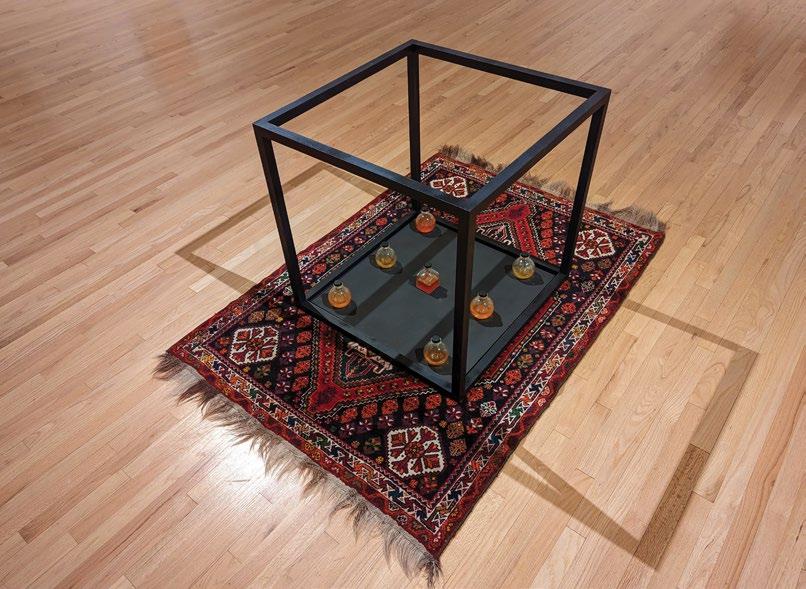
illustrates the immutable beauty and progression of Iranian culture while highlighting systemic injustice and the politics of nature.
In one of her exhibition’s displays, multiple televisions present inaudible footage of the various stages of saffron production, from cultivation to harvest. Saffron is infamously known as a precious spice due to the difficulty of cultivating and harvesting the flower for spice. To produce one kilograms of saffron spice, 150,000 crocus flowers must be handpicked. That’s 450,000 stigmas needed for one kilograms. Moreover, it has to be harvested in late fall during the cold season, with challenging agricultural conditions exacerbated by climate change. The work is arduous and predominantly carried out by women. “The fact that mainly women are involved during this difficult
seasonal harvesting period was a huge factor and attention-grabbing for my work in this exhibition,” Karimi explains. “I read somewhere that the soft touch of a female hand makes for the best harvest.”
“In our religious courses, I was taught that saints did a lot of good and performed miracles. Saffron crocus does both. It is a beautiful, medicinal flower whose use does miracles for the body and mind.”
That may be part of the reason women serve as the majority of saffron agricultural laborers, despite being paid less than the men who package and distribute the spice. “The Women-Life-Freedom movement highlights the plight of female laborers, who must adhere to the strict dress codes during the intense harvesting season,” says Karimi. “Needless to say, the movement also highlights the rights of the female gender in Iran and makes me ponder about pay inequality.”
As flower, spice, and allegory, saffron extends from a religious and gendered motif to something innately political in Karimi’s show. In recent years,
Top: Saffron, Saint of Spices, Exhibition View, Jan-April 2023, Triton Museum of Art, Santa Clara, California
Bottom: Healing Chroma, 2022
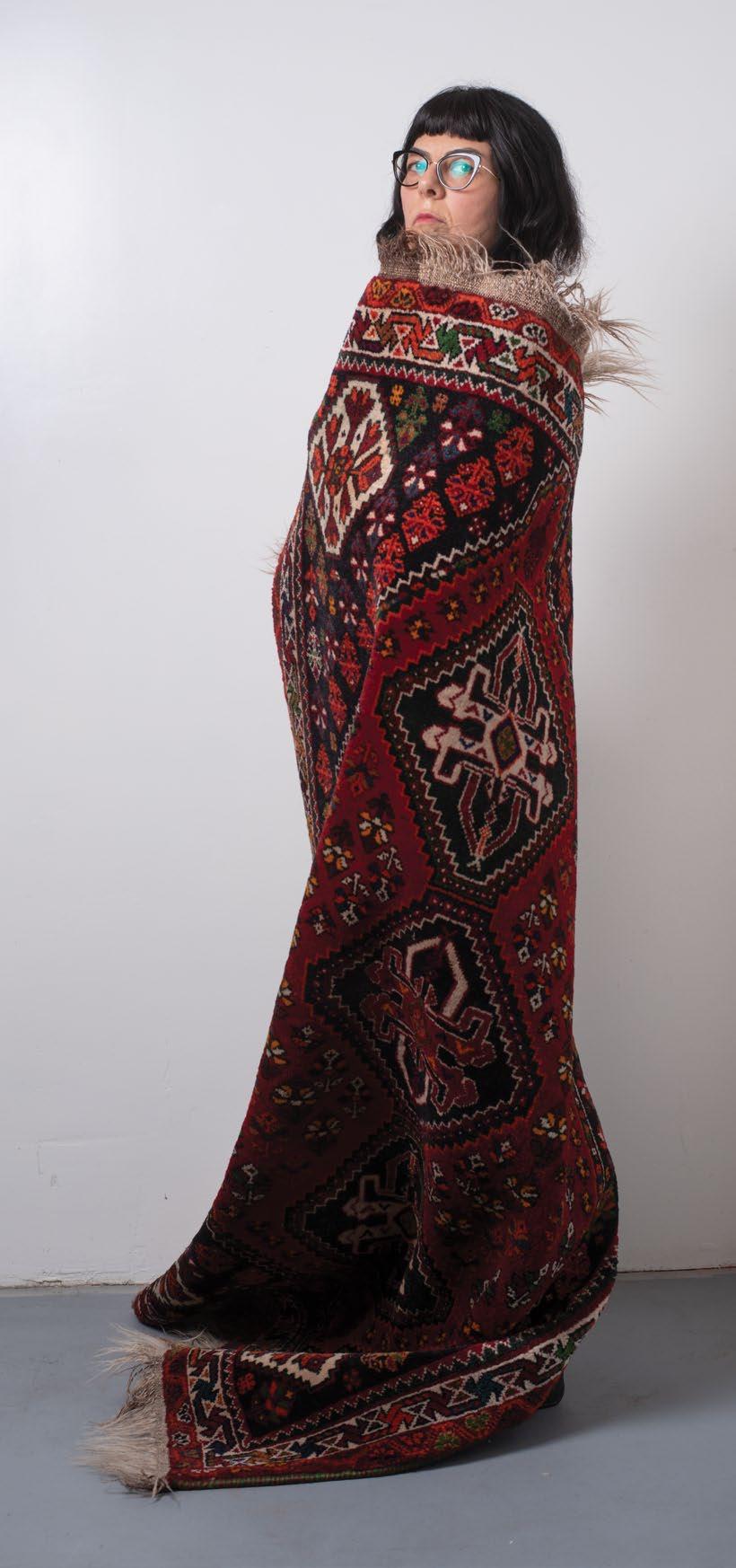
“I can’t separate Iran’s culture from the political and religious issues anymore; in many ways the situation has shaped my mindset.”
the value of spice declined because of the Trump-era sanctions against Iran, making it difficult for Iranian growers to distribute their produce. So, they began repackaging their product as Spanish or Moroccan saffron, at a cut to their already-dwindling profits. Ninety percent of saffron is grown in the northeast of Iran, in the Khorasan province, though these days many kitchens are equipped with saffron labeled as coming from elsewhere.
“For me, this makes saffron a symbol of contemporary economical and agricultural challenges, convolved with ongoing political issues under the theocracy in Iran,” Karimi comments. “My exhibition is the story of the medicinal saffron crocus as a cultural symbol, yet in a political and religious context, because I can’t separate Iran’s culture from the political and religious issues anymore; in many ways the situation has shaped my mindset.”
Still, Karimi hopes her work illustrates Iran’s ancient and future wisdom, not just its postrevolutionary struggles that she’s known since a child. “Iran, with 3,500 years of history, has been under the rule of theocracy for the past 44 years,” Karimi explains. “All we hear is the news of political and religious conflicts but almost nothing about Iran’s history, culture, nature, cuisine, art, or architecture.”
So, her works infuse saffron crocus in a myriad of renditions of adoration and worship—a symbol to be both defied and consumed as medicine, serving as botanical healer and religious icon, to poke fun at religion while decrying injustice, a reminder of Iran’s political unrest and gendered violence while drinking tea with guests in San Jose.
Today, Karimi and her husband incorporate saffron in traditional recipes handed down from generations of families in Shiraz. Throughout Santa Clara and California, Iranian shops offer saffron ice cream, cookies, tea bags, and more.
In 2016, the last time she visited Iran, Karimi visited her hometown of Shiraz and searched for the tea pubs she frequented as a child. She couldn’t find the pubs she recalled from her youth, but the saffron extracts were still displayed from shop windows in jars, light reflecting off the glass in the sacred glow that she remembered as a child. C


The morning before an art event, you might find James Mertke unloading the Tetris puzzle of art pieces and display shelves from his car. It’s been a little over a year since James started participating in art markets, and although he’s still learning the ropes, he’s grown a lot since his first event. He’s created an eye-catching display with hand-painted signage and a variety of shelves.
James can’t remember a time he wasn’t painting. He loves pushing color vibrancy and emphasizing shadows. “I’ve landed on acrylic paints because I enjoy the vibrancy that can be achieved and the fast drying times that encourage me to work quickly and deliberately.”
Talk with James for a few minutes and you’ll find there’s a story behind each brightly colored still life—sliced fruit, donuts, Botan Rice Candy, strawberry “grandma” candies—simple and happy childhood memories captured on canvas. “That’s one
of my favorite things about the things I paint. Just on the surface, it’s a lemon to someone. But when I tell them the story about the lemon tree, maybe they’ll share something about how their grandparents had a lemon tree that they remember.”
During high school, academics became the priority while art took the back burner. James discovered a love of mechanical engineering in 2018 at Santa Clara University. Practicing art became something reserved for weekends at home. But when many doors closed during the pandemic, a door opened for James to pursue art. Commuting time could instead be dedicated to painting. Looking for new ways to practice his craft, James noticed a 100-day painting challenge on Instagram. Over the summer he painted a new piece every day for 100 days in a row. With a time constraint, he spent less time adjusting the same painting and simply applied different techniques to his next piece. The subject of his paintings
also shifted. “Before the pandemic I was mostly painting ocean scenes…I would take reference photos when I went to Santa Cruz or Monterey…When the pandemic happened, I started transitioning to the still lifes, because I was looking for things around my house to paint.”
A prevalent subject in James’s art is lemon slices. He finds eye-catching glassware from the thrift store, arranging and rearranging lemon slices around them to get the right reference shot. James details the strong shadows and vibrant yellows in his art, but the connection behind the lemons is personal and sweeter. The lemons come from the tree in his grandpa’s backyard. “I always say it’s a giant lemon tree, but it’s a dwarf one—I’m taller than it—but it’s the most prolific thing,” he says. His grandpa remains one of James’s biggest supporters and is always thrilled to offer him lemons. After an art market, James will call him to share how it went. “He likes hearing when I



“I’m an artist and engineer. I feel like when people think of engineering it’s all math and logic…but I also like expressing my creative side.”


make a sale…he’ll be so excited and smiling all the time.”
After the 100-day challenge, James improved his skills—and his inventory. “I had boxes and boxes of paintings.” He made it a project to get himself into events and shows to sell his work. Since James didn’t study art or take any art classes, he didn’t naturally find himself surrounded by an art community. He’s worked to find community by joining his school’s art club, frequenting art events, and exchanging art pieces with new friends. The art community he’s found is extremely supportive. “Art is about abundance. There’s not limited space for all the artists,” he explains. “The more art people create, the more opportunities
people create for people to appreciate art, and the more people appreciate art, the more people will want to support artists.”
Early this year, James was invited to show his work at the Elliott Fouts Gallery in Sacramento. His pieces have been curated into an exhibit titled, The Still Life. James also connects with the local community for opportunities to display art at businesses like Voyager Craft Coffee and Fox Tale Fermentation Project.
Recently, James introduced mechanical engineering pieces into his work by snapping reference photos in the machine shop for mechanical engineering–themed paintings. He submitted a series featuring LED lights, electrical resistors, and 3D-printed items
to an art show sponsored by the School of Engineering at SCSU to celebrate the art of engineers. The paintings were acquired by the Department of Mechanical Engineering and now hang in the office.
Mechanical engineering and painting used to be two unrelated interests, but James has found they go hand in hand. “I’m an artist and engineer. I feel like when people think of engineering it’s all math and logic… but I also like expressing my creative side,” he says. “Engineering is creative too, in a different way. I think engineering and art coexist and create some really cool combinations.” C
Have a hand in your city’s history.
EACH YEAR, the San José Office of Cultural Affairs (OCA) recognizes the need for art on a day-to-day basis. Through public art, programming, and grants, San Jose’s OCA aims to give back to the community in heartfelt, intentional ways. This year they have brought back the Creative Ambassadors program, recognizing a range of artistic disciplines practiced by locals who share a deep commitment to San Jose’s cultural community. The 2023 Creative Ambassadors are Yoon Chung Han, Patron Paule, Suhita Shirodkar, and the artist collective Together We Create. Creative Ambassadors are selected through a competitive panel review process that considers the applicant’s artistic track record and their history of community engagement. Emphasis is also placed on artists deeply rooted within the San Jose community. Practicing artists of all disciplines are invited to apply. The role of
the Creative Ambassadors is to champion the power of creative expression and engage residents in finding their own creative voice. Ambassadors serve a one-year term, during which they produce an innovative project that invites active participation from residents and celebrates the diversity of the city’s cultural communities. This year’s Creative Ambassadors are producing a series of events where locals can participate in their city’s history, experiencing the arts as a vital means of connection to themselves and others. Participants will elevate their creativity and celebrate its role in their everyday lives. Through these projects, each Creative Ambassador will demonstrate their love and passion for the city and its community. Support for the 2023 Creative Ambassadors is provided in part by grants from the David and Lucile Packard Foundation.
“I
yoonchunghan.com/portfolio instagram: artofyoonhan
Yoon Chung Han brings together two building blocks of San Jose— art and technology. Her project allows residents to record their stories verbally and then use that recording to create a 3D-printed artwork using recycled materials. Yoon aims to raise awareness about sustainability and cultural heritage by interviewing under-served, multi-ethnic community members in San Jose and the region. “San Jose is a really cool, interesting city. With San Jose being the heart of Silicon Valley and having a multicultural community, I thought it was important to highlight the sounds of the city and its community.
The sculptures are like a time capsule,” she says.
“We should take a moment to listen to one another, listen to our surroundings, and understand one another on a deeper level.” As an attendee of Yoon’s workshop, residents can participate by verbally sharing their stories or a meaningful memory of San Jose. She will then convert the sound into a 3D-rendered sculpture. The San Jose community will have a physical record of these audio memories.
“I hope people will better understand how art and technology can live symbiotically. Public art workshops are essential to give local residents access to technology and gain inspiration for their future careers and to challenge themselves,” Yoon explains.
Yoon is an interaction designer, multimedia artist, and researcher. Her research includes data visualization, biometric data visualization, and sonification—a new interface for musical expression—and mobile user experience design. C
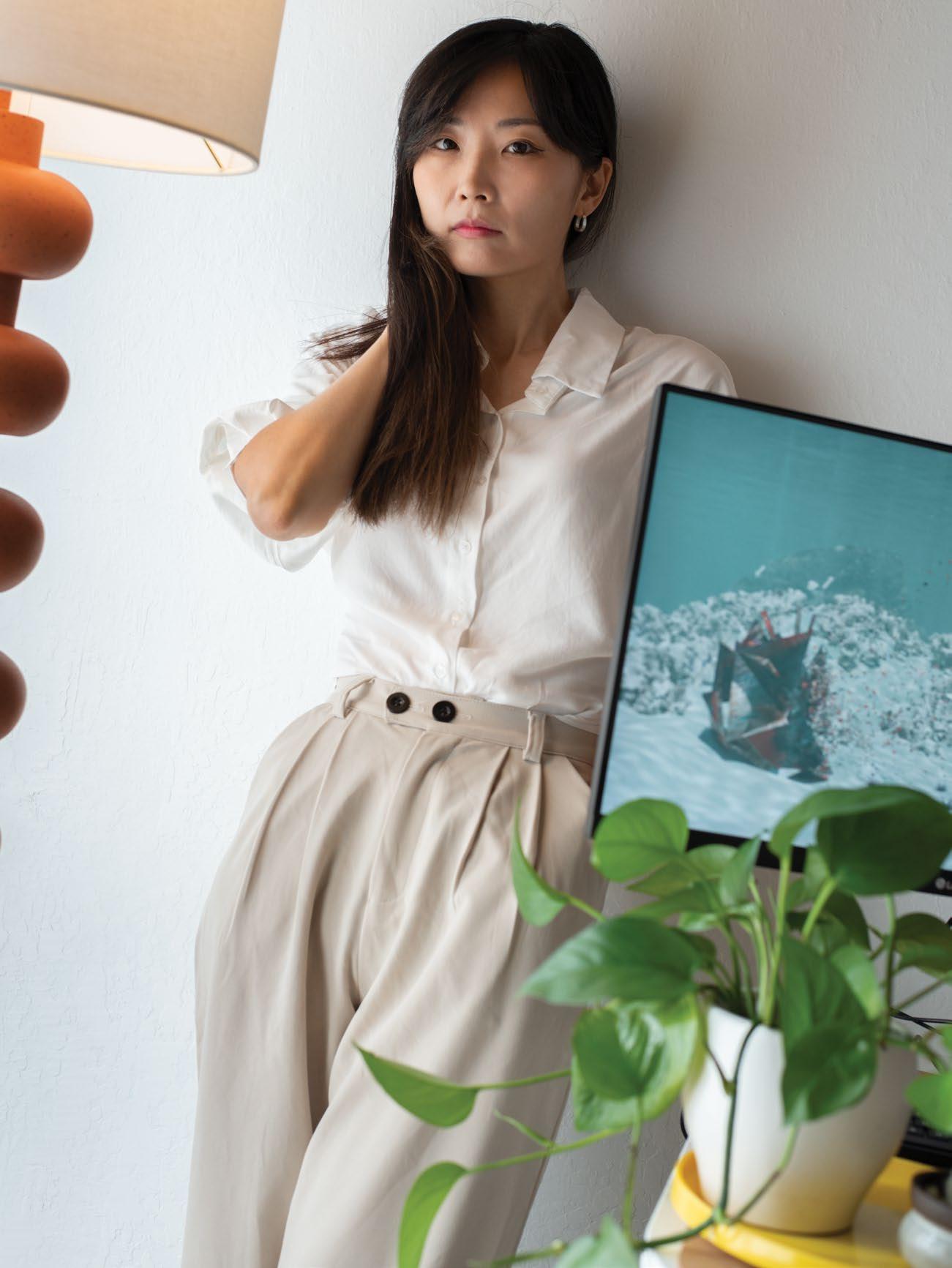

sjstoryboard.com instagram: sjstoryboard
Bertrand Patron Paule’s passion for the San Jose community is palpable. During the pandemic, Patron began organizing community events in LvL Up’s backyard, often funding back-to-back events himself. While he felt like an outsider, Patron’s love for San Jose fueled him to reactivate the community during a rough period, and many enjoyed the live concerts by local acts and movies displayed on the facades of historic buildings that Patron’s energy facilitated. His passion project quickly became what is now known as SJ Storyboard. As a Creative Ambassador, he can use the grant money to continue those events for the San Jose community. “I believe if we take our losses gracefully and move forward with quickness and ferocity, we can do more than just reclaim our space. We can change how San Jose survives the future and create an environment where our community feels safe. We can keep our identity and continue to thrive,” he says.
Patron bridges our diverse San Jose communities through digitally immersive storytelling events and illuminated public art installations throughout downtown. As a digital graphic artist and SJSU alumnus, his core work involves constructing immersive environments with communities by narrating visual illustrations that are projected onto architecture and buildings. Through this, San Jose’s rich cultural identity is supported by amplifying the multiple perspectives of its people. SJ Storyboard continues to create a sense of belonging through shared experiences across local venues.
“In our lifetime, we’re constantly losing and gaining something in big ways. We must appreciate what we have now,” he claims. C
“IN OUR LIFETIME, WE’RE CONSTANTLY LOSING AND GAINING SOMETHING IN BIG WAYS. WE MUST APPRECIATE WHAT WE HAVE NOW.”

suhitasketch.com
instagram: suhitasketch
Sketching stories is Suhita Shirodkar’s superpower. Her wonder at San Jose’s history pushed her to explore through walking and sketching, capturing the essence of her new city. As a first-generation immigrant to the valley, Suhita allows sketching to be her compass, navigating the archives and neighborhoods. “To sketch like that, to discover, the importance is on the seeing. You’ve walked a moment or a place with your eyes to draw it. It’s not sketching to become an artist; it’s sketching to see, to become intimate with your environment,” she clarifies.
Suhita’s project will allow attendees to experience San Jose from a new perspective. Whether you’re a native or a transplant to the area, a sketch walk will allow the public to build a new relationship with the city, not by becoming an artist but by being intentional with how one interacts with their surroundings. Each sketch walk is accompanied by someone familiar with the neighborhood who will share their knowledge of the city’s history. “I want everyone to walk away with their own visual record in their sketchbooks, creating a deeper connection to the place they call home,” Suhita says.
Suhita Shirodkar is a reportage artist and educator. She leads sketch workshops and sketch walks worldwide. Her recent San Jose–based projects involve documenting the vintage signs around San Jose in sketches and sketching portraits of people in recovery from addiction and homelessness. Suhita is currently a resiliency resident with WIRED magazine and holds a master’s degree in communication design from Pratt Institute. C
“IT’S NOT SKETCHING TO BECOME AN ARTIST; IT’S SKETCHING TO SEE, TO BECOME INTIMATE WITH YOUR ENVIRONMENT.”
“WHEN YOU SHARE AN EXPERIENCE, YOU BEGIN TO CARE ABOUT EACH OTHER.”
instagram: twc408 wispertfl | huesomacizo theelbaraquel | mesngr86
Together We Create connects culture and community by creating a habitat for the arts. Through live painting at self-organized events, the crew empowers artists, youth, and the general public to come together and experience all art. The second generation of this artist collective features four San Jose–based artists: Wisper, Mesngr, Elba Raquel, and Roberto Romo. Each artist brings their strengths and skills to the group, creating a positive force that helps other artists and the San Jose community and beyond.
“A lot of artists have a scarcity mindset. They don’t want to share anything; they don’t want to tell anyone how they made something,” says Wisper. “There’s enough here in Silicon Valley, and the world in general, for everybody to eat. I want to help others thrive.”
Fellow crew member Mesngr shares the same sentiment when it comes to helping his fellow-artist community. “We feed off of each other. It’s a great thing to be accessible to the community in an educational way.”
Together We Create’s project Paint Together is a series of live painting events across different San Jose spots, bringing together graffiti, music, dance, and food. “We create this cultural habitat where each art form connects to one another,” shares Roberto.
“It’s about connections, the artists to the artists, artists to the community, the community to themselves.” Elba explains, “When you share an experience, you begin to care about each other.” As Creative Ambassadors, the crew’s drive to make sustainable changes in the art scene will be unmistakable. C


Since becoming CEO and founder of her own production house, MYStudios, May Yam has not only gained a Primetime Emmy nomination but has served as a judge for the Emmys for over a decade. Her work has been seen on CNN, ABC, FOX, Lifetime and CBS. As a seasoned filmmaker and Cinequest’s Virtual Reality (VR) Programs and Film Producer, May has explored genre storytelling, but her heart for people is most evident through her documentary work.
May recounts filming Healing Hands, a documentary about girls in Namibia that undergo pro-bono medical procedures correcting lower body deformities. “The true gift for me was really just simply the wealth of information and perspective that I gained from interviewing [the brave patients],” May muses. “It really opened my narrow worldview to a profound appreciation for life in a developing country.” When the documentary was showcased at the 2017 Silicon Valley African Film Festival, May was honored with an award for Achievement in Documentary Short Film. An equal gift was from a Namibian woman she had just finished interviewing, who ran through the rain to give her a very special present. As the beaming woman extended a wet plastic bag, a bedraggled chicken poked out its head to eye May with indignation. “It was a truly touching gift of appreciation!” May laughed at the memory. “It was the family’s main source of food for probably a week!”
From a young age, May already had a storyteller drive. “As soon as I got my hands on a camcorder, I became the director extraordinaire of my own home movies,” she recalled with a chuckle. “I dragged all my friends and family—definitely kicking and screaming—and I put them into my cinematic adventures. Because, I mean, what else is there to do, right? How else are they going to spend their time but making movies with me?”
Written by Johanna HarlowThe childhood movie that’s had the biggest influence on May might seem to come from an unexpected direction. It’s Steven Spielberg’s E.T. the Extra-Terrestrial. “I remember just being so deeply moved by the sad parts of the film, the touching moments—to the point where I just cried uncontrollably,” she recalled. “I was so amazed at how a simple rubber suit alien could evoke such strong emotions in me.” It was a pivotal moment. “That was when I realized that I really wanted to be able to lift spirits and make others feel that kind of joy through storytelling,” She grins. “Steven’s the man!”
Songs are another inspiration for May: “I’ve always strived to make my films as pure and as beautiful as music itself,” she said. “For me, I think music has always been just the most expressive art form there is and is capable of conveying complex emotions. It has a way of capturing the essence of a moment.”
When May first moved from England to NorCal, she came to



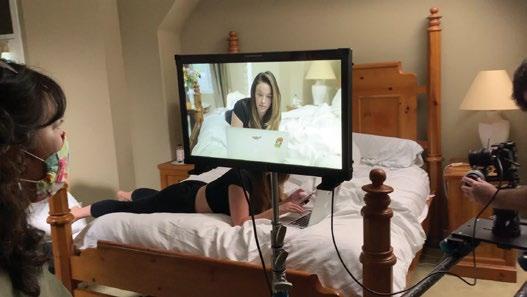

“My films aim to bring awareness and spark conversations on important topics.”
pursue computer science, not film. It didn’t stick. “I just felt like I could do more,” she said. Besides, cinema was in her bones. May’s grandfather made over 50 films as a prolific Hong Kong director. The itch to tell humanitarian stories only grew after the birth of her daughter. “I started thinking about the challenges that she would face as a woman from the unrepresented minority community—and I wanted to contribute to creating a better and more inclusive future for her,” May reflects. Her upcoming documentary, Egg Whispers, will explore the fight for fertility (an issue she herself has faced). “I want to give a voice to those who have struggled in silence,” she said. May said, “My films aim to bring awareness and spark conversations on important topics.” Like Headwind, a film about a family roadtripping to complete their terminally ill daughter’s bucket list, and Xmas Cake: This American Shelf-Life , which unpacks the noxious mindset equating unmarried women over 25 with stale dessert. The poignant Xmas Cake, which May directed, produced, and edited, was nominated for best short documentary at Tribeca Film Festival 2019 (out of thousands of submissions). It then toured with Lunafest, a traveling film festival celebrating and championing women in film. “This film really sheds light on the problem of stereotyping,” May said. “We aim to challenge and dismantle it.” May also supports other women by hiring them for work in front of and behind the camera whenever possible.
As for her Cinequest endeavors? For the past seven years, May and her studio have led the film production team, helping with everything from creating the tribute videos for the Mavericks winners to making the marketing videos to capturing big festival moments like the red carpet. May also oversees the film festival’s VR Experience Lounge and VR Cinema programs. The first year she took over the lounge, attendance went up tenfold. “Actually, my first virtual reality experience was at Cinequest ,” reflected May, fondly describing her encounter with a VR whale (compliments of theBlu). “First of all, being in the water without scuba diving equipment and staying dry was a win-win right there,” she said with a smile. “Then to be just immersed into this world where you are literally eye-to-eye with this whale that’s passing by and you can hear them singing…It just blew my mind!”
Since then, she’s made her own VR film, The Sight of You, which raises empathy for issues of homelessness and those who struggle with suicidal ideation. “VR films create immersion and empathy,” May summed up. For a wholehearted humanitarian, does it get any better than that? C
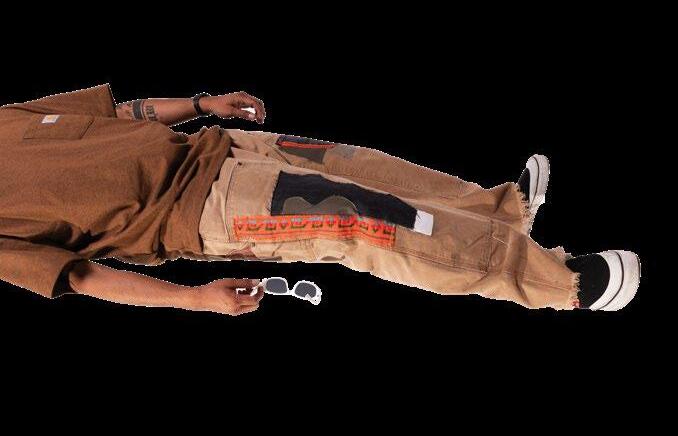



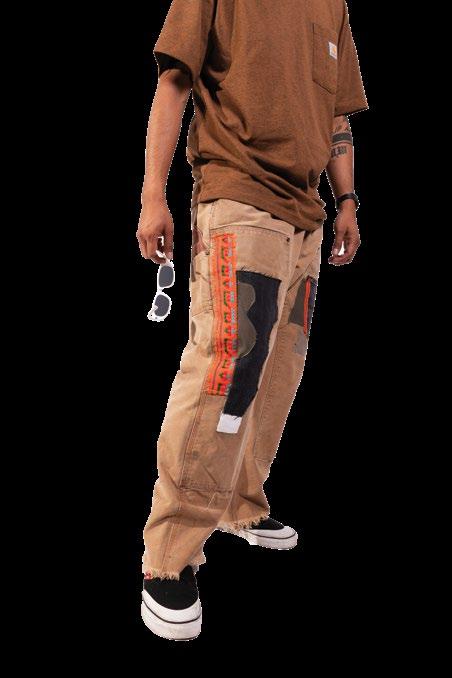



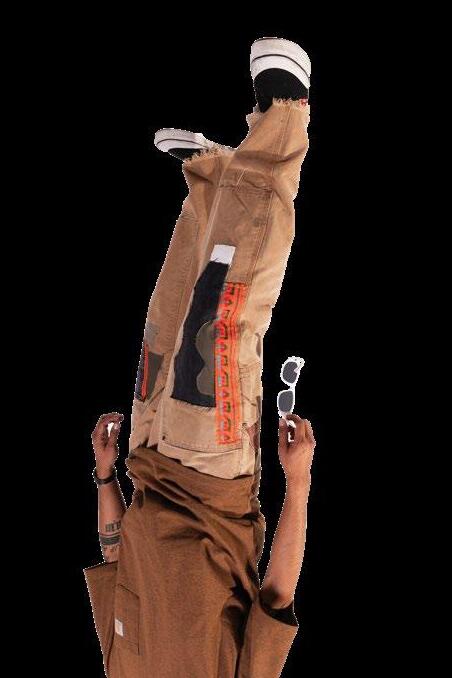

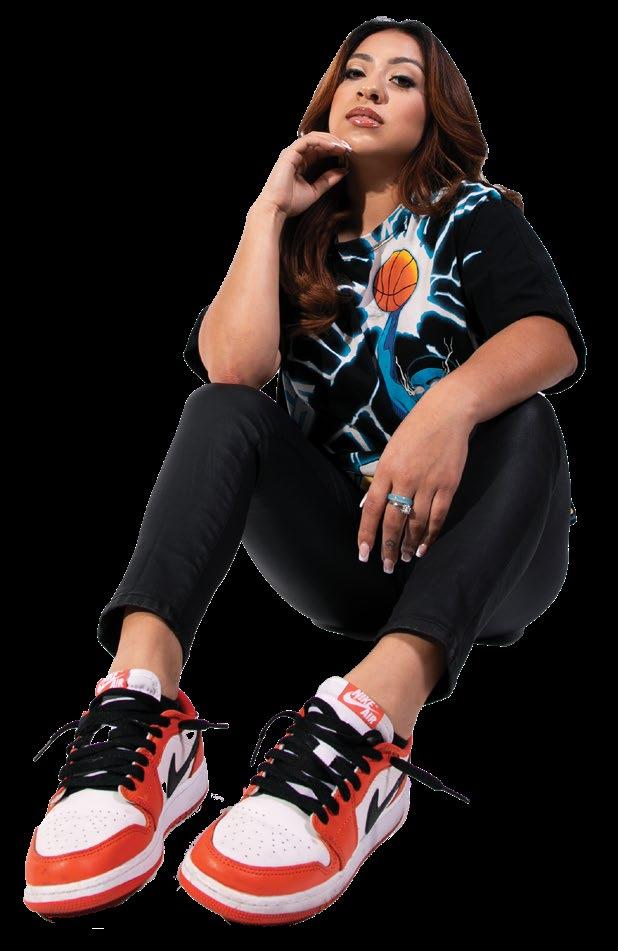
Quiet vs. Chaos: The internal battle of every artist and how one can display that battle in their art.
hen you’re creating art, inspiration can come from anywhere, but there’s a pattern seen in true expression that either comes in the form of loud or minimalist art. Loud art is Basquiat, taking all the ideas and building a world around it with every possible tool you have. Minimalist expression is Coco Chanel. A simple bag by Chanel in its most minimal form can say more than the most expressive Gucci or Versace piece. Loud is punk rock or hip-hop, an abrasive display of soul and creativity. Minimalist is R&B, a simple and quieter display of affection and love.
Meraki by Yaya is a display of that internal debate every great artist has. Quiet vs. chaos. Loud and bright vs. minimalist and simple. Yaya Bautista is a San Jose fashion designer who started her brand as a boutique but didn’t want to settle for being another streetwear company “making tees and hoodies.” Her appreciation for designer and couture fashion is what sparked her to take risks with Meraki. Meraki is a display of her love for self-expression through clothing. She knew from the beginning that this would be her jumping off point, starting as a stylist at Nordstrom and observing what stayat-home moms were buying with their money; she draws her “tomboyish” inspiration from growing up with her brother. She knew she wanted to express herself in a multitude of ways, and it can be seen in the attention to detail she presents in her designs.
Written by Troy EwersPhotography by Gl-o
Photography Assistant
Jonathan Guillen
merakifashion.shop
merakiby_yaya
Yaya’s attention to detail is specific to her process; for example, every time she travels, she makes sure to buy fabrics she’ll be able to use for future projects. Her conscious effort to always buy fabric in places she travels to, whether it be for business or leisure, challenges her to take risks and sparks her creative process. Her process can start in many ways. Yaya’s latest design, most recently a pair of basketball shorts, started with a silhouette that wasn’t specific to men or women—Yaya has never liked to classify her designs as gender-specific. As she holds up her latest jacket design, Yaya makes it very apparent that man or woman would feel and look great in the jacket and speaks on how it’s limiting to only make things for one “group” when, in reality, it’s for any person who appreciates it.







“Trial and error and my time are the most important things to choosing what works for me.”
For Yaya, the battle of quiet vs. chaos is the hardest part about being an artist, but she battles it by channeling a lot of her ideas into the right place. “Trial and error and my time are the most important things to choosing what works for me,” Yaya says as she looks at the designs she is working on for her new collection. “Loud” colors and patterns come from her Latina heritage, whereas her “minimalist” approach stems from her appreciation for designer fashion. Even through the inner battles of deciding her approach, she creates pieces and learns while doing so, studying a new style of cut and sew while also preparing a new collection. As she grows with her designs, she takes more risks and sails further away from the island of streetwear she never wanted to be stranded on when she designed her first bandana hoodie (and Meraki’s first released garment).
Meraki means doing something with soul, creativity, or love. This name is not only perfect for what Yaya expresses in her designs, but also for her vision for her career: “My vision for my dream fashion show is a local, public show with other designers a part of it and I’m radiating happiness wearing one of my designs, surrounded by my friends and family.” Yaya wants to be remembered as a person who is not afraid to be herself and represents where she came from—someone who is determined and known globally, just like her inspirations and fellow designers she dreams of collaborating with, Kid Super and Rhude.
Like most artists, Yaya combats doubts and insecurities, along with the internal debates of mainstream vs. underground, solo vs. collaboration. She approaches her artistic challenges with the same motto: if she infuses her art with soul, creativity, and love, then it doesn’t matter if it communicates as quietly as a library or as San Jose during the holidays. If it’s ativity, and love, it’s done the Mer-


Nationally acclaimed poet and public speaker Yosimar Reyes is no stranger to San Jose’s spotlight. Born in Guerrero, Mexico, and raised in Eastside San Jose, Reyes draws much of his inspiration from his experiences as an undocumented immigrant and member of the LGBTQ+ community. Between his rich, illustrative language, sharp wit, and thought-provoking messages, Reyes leaves a lasting impression as he navigates subjects like migration, sexuality, and socio-economic struggle.
As a performer, Reyes has a playful, charismatic personality combined with a dynamic stage presence; he performs with exuberance, drawing in the audience with the steady rhythm of his spoken word style and clever use of Spanglish. The stories he shares are full of vibrancy and dimension at their core, celebrating the resilience of marginalized communities.
Now Reyes finds himself starting a new chapter as MACLA’s first-ever Performance Artist
in Residency (PAIR). With this new role, Reyes will curate performance programs, workshop material, and showcase featured artists—actively shaping the San Jose art scene while cultivating an inclusive creative space designed for Chicanx/ Latinx narratives. But most importantly, it’s a “fullcircle moment” for both him and his artform. Reyes himself started performing poetry at MACLA when he was just 16 years old. Back then, his work was rooted in survival. “I grew up in this rich community with all these immigrants that would just hustle,” he shares. “I started writing poetry because I [needed] to make money to help my family, and it so happened that people found out [about it] and it took off.”
In school, Reyes was a self-proclaimed nerd who excelled academically, in part because of his love for books and reading, but also to compensate for the insecurity he felt as a closeted gay teen. With some encouragement from his teacher, Reyes started using poetry as an outlet, then dove into doing live
At her age, her body feels it can’t deal
She calls me
I’m at a bar
Trying to distract myself from the responsibilities of being a caretaker
I know it took a lot for her to dial
Abuela swallows her aches
Because she is mindful that I have my own life to live
“Hey, I got to go home,” I tell my friends
At home, she is in bed
“Sorry,” she says
She doesn’t know it’s an honor. It’s my duty.
Her body is shirking. I rub vapor rub on her back, her pecho, her arms, her legs
“You are a good son,” me dice
But it’s not about goodness
It’s about time
How fast everything is moving
It’s about the now
About savoring
It’s life
This moment
Yo, rubbing vapor rub on this viejita that loves me
I touch her skin, memorizing its texture
Very few people get the blessing of knowing a love so sacred.

performances with institutions like MACLA and San Francisco’s Youth Speaks nonprofits.
When the May Day marches took San Jose by storm in 2006 as the largest political demonstration in the city’s history, Reyes saw it all firsthand.
“A lot was happening in the country,” he says, recounting his high school years. “This [was] the beginning [of when] a lot of people were coming out as undocumented…they [would] go on TV, tell their stories, then they get pixelated, or they alter their voices.” He was particularly compelled by the younger people galvanizing the movement, coming together to amplify their stories in solidarity.
Reyes’s first collection of poetry, For Colored Boys Who Speak Softly , published in 2009 with the support of musical legend Carlos Santana, serves as an archive of this emotionally charged period in Reyes’s life. And while he admits the collection would be received differently now due to its outdated language, publishing it ultimately convinced him to pursue his passion as a storyteller.
In the beginning, Reyes didn’t mind being called an “undocumented writer,” but as he got older, he felt the need for distinction. “My work, yes, deals with that theme but it’s more about a human element,” he states. “I always tell people, I’m a writer that happens to be undocumented. That informs the work, but it does not define how I view myself.”
When Reyes was confronted with the pandemic, he chose to pivot from his career in LA and move back home to San Jose to be with his grandmother.
Among his many projects since then, Reyes takes extra pride in the creation of the Yosi Book Club in 2020, promoting a variety of Latinx authors and the premiere of his renowned one-man show Prieto in 2022—an adaptation of Reyes’s own coming-ofage story in the Bay. For him, the writing process for all his work, including Prieto, is intimate and cathartic. “What I’m living is what I’m writing,” he says. “It forces me to be a little more honest and confront things that I don’t want to.”
When he leads his creative writing workshops, it can be especially nuanced for Reyes. “I work with a lot of college engagement, first generation college students. Most of the students have left their families [so] I think that’s why we connect,” Reyes explains. He recognizes a familiar resilience in his students—a desire for economic stability that could potentially trickle down and help their family, which Reyes knows all too well. “They know this [part’s] temporary and it’s gonna pay off in the long run. We want to thrive, we don’t want to [just] survive.”
Wherever Reyes is involved, it is guaranteed that he will be outspoken and authentic, willing to share the spotlight with anyone with a story to tell. Undoubtedly, Reyes will bring this and more as he sets the stage as MACLA’s newest addition. He additionally anticipates Prieto on tour this fall, premiering in Chicago and Miami. C

An avid childhood reader, Elodia Benitez aspired to one day write a book of her own. Inspired by the books she read, Elodia felt like she could write stories just like the ones in her books. Fast forward to the present, it’s safe to say that Elodia—after publishing her first book of poems—has come a long way.
Elodia started writing her own stories at the age of 10. “It started off with me writing little tidbits,” she says, “but when my writing style started to develop, I found that what I really enjoyed doing was writing these little descriptive pieces.”
Written by Daniel Arriaga Photography by Danielle Caryl Robinsonbit.ly/LoveInManyFaces Instagram elodiabenitez
After years of writing small stories, Elodia started pursuing poetry. Exposure to other forms of writing helped her find her own style, which allows her to tell stories in a way that is true to herself. “I really gravitate towards poetry that has a narrative,” she says. “I really gravitate towards making a picture, like a little scene. I like using different voices of people having a conversation within a poem.”
Many artists have been inspired by someone more famous, and Elodia doesn’t shy away from sharing who her inspirations are. Many of them are authors of classics she read in school: Maya Angelou, Robert Frost, and Sandra Cisneros. However, contemporary poets have also made their mark on her. “I’ve also gained inspiration through poets that I’ve gotten to meet and work with,” she says, “like Rosanna Alvarez who I’ve had the pleasure of knowing. She’s a poet out of San Jose. And also [Tshaka Campbell] the poet laureate out of Santa Clara County. I really like his work.”
When creating a poem, there are many thoughts and feelings that go into the process. For Elodia, this process starts with a phrase or a mental picture. An example she gives is the image of a group of girls walking the track in middle school. She describes, “You know, there’s always that little group in the back that doesn’t run—they walk and, like, chisme back there? I had that image in my head,
Love in Many Faces
I have known love
Wrapped warm
In the exhale of home
Love in Many Faces
Of worry to shake away
All consuming fear
Tethering bone deep
Love in ear-splitting fondness
Joy biting through fruit rind
Grief wails
Reverberating from the heart
The longing in a last embrace
Even still, I have known
The love of laughter at funerals
Esperanza, the steady neck
Holding up love
In Many Faces
Whispering
“Maybe, this time…”
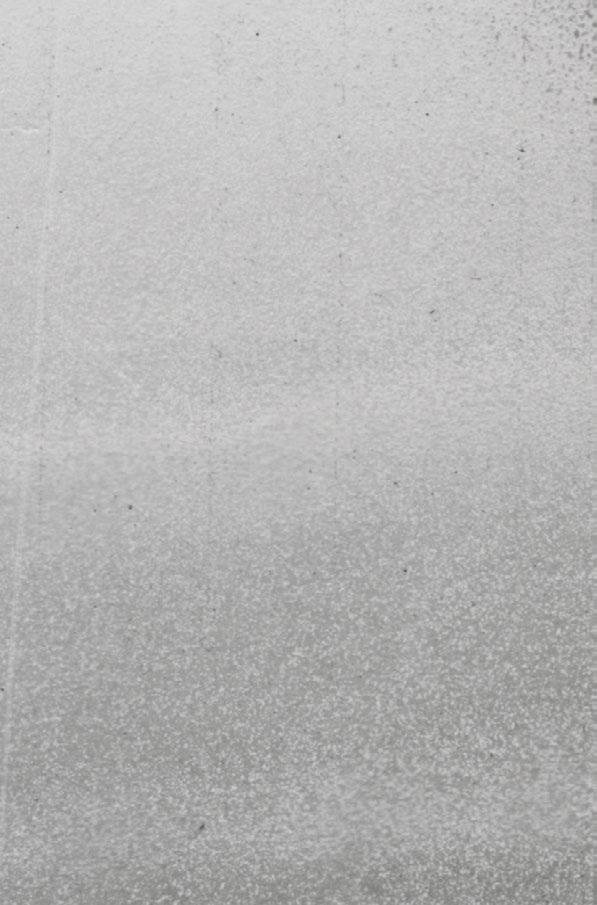
“I think art is at its most beautiful when you’re using it to give back or make others grow.”

but I didn’t have the structure for a long time.” So she sits with it, letting the narrative develop through reflection and questioning. “I try to figure out what we’re talking about,” she says. “What’s going on? What’s happening?”
Her creative imagination also feeds her ambition. After years in the world of poetry, Elodia decided it was time to take it to the next level and selfpublish her poems as a book. “I had a picture in my head about this big chunky collection that’s about 80 poems strong,” she says. She imagined the poems as tied together with specific themes like coming of age, Mexican culture, and family.
Before that, though, she tried a smaller foray into selfpublishing. Elodia recalls, “I had a collection of poems that didn’t really fit into any collection that I was trying to put together. These poems were very love relationship based, and I tried to put them to the side. But they were kinda just there by
themselves.” Eventually, she decided to just go for it and publish these 15 poems so she could get her feet wet and experience the process of selfpublishing. “It’s really special to me,” she says. “I designed the cover. I designed everything. I even formatted it myself. It’s very much a collection of love and a work of love.”
Now a published poet, Elodia sees this as only the beginning. She has plans for the future—not only for herself, but also for her community. This fall, she has a poetry collection coming out through Riot of Roses Publishing House. In general, she’ll be touring open mics in Santa Clara County and supporting other artists at cultural events. She also wants to start doing poetry workshops and creative writing events with kids and young adults in her hometown of Gilroy. “I think art is at its most beautiful when you’re using it to give back or make others grow,” she says. C

 Written by Brandon Roos
Written by Brandon Roos

The concept of permanence is important to Aaron Aquino. When the bubbly solo beatmaker and miner of controlled chaos for the DJ-production collective the Bangerz creates nowadays, he hopes his grandkids, yet to be born, will someday hear his music with a sense of pride.
In person, he’s all laughs, light-hearted and transparent in a way that shares the fruits of a long journey of self-reflection and acceptance. He admits to being walled off in his early years, unable to carry much emotion in the aftermath of losing his father at age six. His heart started to soften in 2014, when he found out he was going to become a father.
“I [thought] ‘Dang, I’ve got to be this dad that I didn’t get to experience,’ ” he recalls. “I’ve got to train them up to be a warrior in this crazy world. How am I going to do that? I’ve got to work on myself,” he continues.
Through that process, he developed his own appreciation for the healing power that music and creativity played in his life. As it stands, the father of two isn’t just making beats for fun anymore. He’s now offering a roadmap through his example.
His creative touch pairs hip-hop sensibility with the relentless push for innovation he picked up in the turntablism scene. But he’s also got a few surprising dashes of influence. He enjoys the in-yourface aggression of heavy metal that his older cousin introduced him to through the sounds of mainstays like Metallica and Slayer as they drove around in his cousin’s Jeep Cherokee. In later years, he was attracted to the electronic experimentalism of producers like Squarepusher and Aphex Twin.
These influences mingle seamlessly in his sonic palette: raw drums, metallic cymbal strokes, punchy bass kicks, jagged audio cuts. A fan of surprise twists, he makes his beats feature abrupt, half-time tempo shifts and mid-song musical re-imaginings, his drum patterns and melodies suddenly flipping into new musical contexts.
At age nine, he remembers being mesmerized by a four-track cassette mix his older brother brought home. The collage of layered



“I
made 86 Mongoose because I found riding a bike was my meditative state. Riding that cool bike was my equivalent to [Dr.] Dre’s ’64 Impala, or Ice Cube in the It Was a Good Day video.”


sounds blew his mind. He had no idea how it was assembled. At a house party later that year, when his brother’s friends hauled speakers and turntables into his garage, he learned that records could manipulate sound just like he heard on that cassette. Video games fell out of favor; now all he wanted to do was scratch . In October 1998, Aquino and five other aspiring DJs formed the Fingerbangerz (now the Bangerz) at fellow member Cutso’s 17th birthday party. They gained acclaim in the world of turntablism, being crowned DMC Regional Champions in 2001 and ITF Western Hemisphere Team Champions in 2000. In more recent years, the group has earned international recognition as the musical bedrock for the hip-hop dance crew the Jabbawockeez. They’ve soundtracked every show the group has performed on the Las Vegas Strip. Though the Bangerz are no longer actively performing, Aquino has become one of the group’s standout solo forces, dropping a remix EP and digital singles. In early 2022, he released 86 Mongoose through Needle to the Groove Records. “I made 86 Mongoose because I found riding a bike was my meditative state,” he says of the album, a collection of spacious tracks that evoke slow momentum. “Riding that cool bike was my equivalent to [Dr.] Dre’s ’64 Impala , or Ice Cube in the It Was a Good Day video,” he shares. Kanye West’s Yeezus was in rotation at the time, adding to the post-apocalyptic feel of a COVID-shuttered world as he traced skid marks in the Great Mall parking lot. He’d go home and work on beats after these sessions of quiet
flection and began sharing ideas with longtime friend Rey Res, a rapper and fellow producer who became a sound- ing board. The two met every Friday to talk through beat selection, track changes, and art direction, thoughtfully whittling drafts into the 17-minute final product. He laughs, “I don’t [express myself] by calling my homie and saying ‘Hey, I’m feeling like this.’ ” He contin- ues, “I’m glad I have music to put that down somewhere, because if they don’t know where to put it, it consumes some people.”
Since rediscovering the critical space music occupies in his life, he’s been careful to keep it as a regular outlet. As a father of two, his time to create is more limited. That’s also made those sessions feel that much more significant.
“We try to show them both [ways], where there’s the traditional route of doing things, but if you work really hard and you’re passionate about something, and you totally believe in it and believe in yourself, it could flower into something great, no matter how weird,” he says. He continues, saying that he is “making projects with a purpose of legacy” to show his kids “that Dad never stopped doing art and that it’s an okay thing to do.” C

KAYTRAMINÉ
Kaytraminé
(CLBN LLC / Kaytranada Music)
Release Date: May 19, 2023
Written by Brandon Roos
“Kay sent me free beats back in 2015 / Now it’s 2023 and we got racks in our jeans.” This couplet brag midway through “UGH UGH” captures the spirit and context of producer Kaytranada and rapper Aminé’s new collaborative album, Kaytraminé, well. It’s a carefree, 11-track set ready to invade summer playlists that shouts out the pair’s collective success but often dwells a bit too much on carnal pleasure.
Opener “Who He Iz” and single “4EVA” pair Kaytranada’s signature bounce with double-time flow, Aminé effortlessly confident. “STFU3” shows Kay is still completely comfortable delivering a new age hip-hop knock behind the boards, while “Eye” features an impressionistic verse from Snoop Dogg wishing to push through relationship struggles. His bars about reconciliation appear in stark contrast to Aminé’s repeated boasts of sexual prowess, no matter the female. While the subject matter is rapper cliché at this point, he revisits the topic enough across the project’s 33-minute runtime to sound one-dimensional lyrically at times.
Despite this gripe, it’s clear the duo has solid chemistry. Based on Aminé’s receipts on social media, they’ve been fans of one another for years. It’s evident Aminé has listened to Kay long enough to confidently ride his beats of varying tempo, whether it’s half-time trap, soulful sampled hip-hop, percussive afrobeat or midtempo steppers.
“Can’t be your true self while seeking validation / Gotta learn to let go, that’s infatuation” Aminé repeats on standout “K&A.” It’s a nice slow-burn closer, with Aminé spitting until the volume slowly fades on him, proclaiming “Y’all bought the same fit but couldn’t buy the steeze.”
Effortless cool is the game plan from start to finish. It’s edgy enough to not feel sanitized and never jarring enough to warrant repeat skips. Ultimately, it’s a fun project made by eager collaborators that never rises high enough to be considered more than good.
Favorite Track: “K&A” KAYTRAMINE.COM
Social media: kaytramine

Chow Mane
AZN Dragon: Cake Long (Five Spice Entertainment) Release Date: May 19, 2023
Written by Esther YoungIn 2017, an unorthodox track rose up on SoundCloud’s algorithm. It blasted through frat party playlists, racked up reblogs on Tumblr, and received 400k views for its music video on YouTube. That song “ABG” incidentally launched a music career for San Jose’s own–Chow Mane, or Charles to his friends. He just had to swerve around some boxes.
As a child of divorced, low-income immigrants, his representation of “third culture” experiences is prevalent. Across international hip-hop markets, he stands out with his ability to rhyme Mandarin, Cantonese, and English together into well-timed jokes. Yet his prolific storytelling also resonates with anyone grieving a breakup or facing off their own ego. Mining through the material that is his own life, Chow Mane has churned out a robust discography that bolsters him from folding into an “Asian Lil Dicky.”
If versatility is Chow’s superpower, his latest full-length album, AZN Dragon: Cake Long, declares the courage to use it. With a cover inspired by American Dragon: Jake Long, the early ’00s Disney show about a Chinese-American teen who’s half-dragon, the project pairs new tracks with loose singles. Familiar collaborations like “San Jo to K-Town” and “BEYBLADE” shine light into a world that is distinctly West Coast Asian-American, while “Bing Ji Ling” celebrates the rewards of the hustle—served with classic Chow Mane humor that leans into cheeky translations.
As on most of his albums, he switches sounds often. “Last Dance” floats a simple club beat over spacious synths, but its driving bpm complements halting melodic line breaks in the chorus. This new song is preceded by its sonic opposite, “ABG 2: The Revenge of Kevin Nguyen,” a rainbow-bubblegum-pop take on future-bass EDM that playfully recontextualizes the archetype in its 2020s era. Chow closes out with “Shanghai Summers.” an intimate portrait of his mother’s journey.
A listen through Chow’s latest project reminds you he doesn’t fit a mold, and neither do you.
Favorite Track: “Shanghai Summers” Instagram: chowmane
 Curated by Needle to the Groove Instagram: needletothegrooverecords
Curated by Needle to the Groove Instagram: needletothegrooverecords
Portrait of a Dog (Innovative Leisure)
Release Date: January 27, 2023
Written by Taran Escobar-AusmanJonah Yano’s strained and vulnerable jazz croon inhabits the quiet forgotten corners of a dusty bedroom. On his sophomore effort, Portrait of a Dog, this almost whispered vocal approach seamlessly glides over meandering yet controlled arrangements played by long-time collaborators BADBADNOTGOOD. Yano leans heavier on the jazz sounds of his backing band and leaves out the soul and electronic elements found in past recordings. His introspective and sentimental lyricism stays intact, however, painting a heartfelt meditation on family and loss.
Portrait’s lyrical themes were born out of Yano’s effort to preserve the past in order to move forward. As his grandparents started to lose their memories and he dealt with a heavy breakup, Yano traveled to British Columbia to collect family stories. Recorded conversations from these visits are sprinkled throughout the proceedings, adding to the reflective meditation on reconciling the past to find identity. The title track circles around familial grief as Yano sings, “Thе tide doesn’t change thе sea / But it sure sinks its teeth in me / If I’m holding on to you.”
Yano’s poetic and graceful delivery holds the listener in a suspended state as the genre-fluid arrangements manifest lo-fi, folk-infused chamber jazz improvisations, perfectly extending the breadth and emotional currency of Yano’s lyrical themes. The mesmerizing Vashti Bunyan cover, “glow worms,” highlights the psychedelic guitar workings of Leland Whitty as the track builds over a simple, repetitive bassline. On “haven’t haven’t,” acoustic guitar highlights the quiet passages giving in to a dream-like saxophone solo.
Portrait of a Dog is a warm and inviting jazz-vocal album beautifully recorded as an introspective journey scored by ethereal and bittersweet lullabies. While some fans may find the heavier jazz leanings subdued and vanilla for Yano, the album successfully expands his art form into a more deliberately executed space, while retaining the experimental and dream-like ambiance that makes his songwriting so special.
Favorite Track: “in sun, out sun”
JONAHYANO.BANDCAMP.COM Instagram: jonah____________

billy woods and Kenny Segal Maps (Backwoodz)
Release Date: May 23, 2023
Written by David MaHis words resonate like the silence following a dud grenade. The command of his voice is currently unmatched in the rap sphere and the imagery in his sentences is as writerly as they come. His gifts have recently been venerated by the likes of Rolling Stone and NPR, but the span of his career is far greater. Billy woods might be the best writer working in rap music at this very moment.
Maps is billy woods’ second collaboration with Kenny Segal, an LA producer who’s lurked in the modern underground for the last few years. Their 2019 release, Hiding Places, is a masterwork of words coupled with appropriate moods and imagery. Since then, woods has been on a productive spree that’s garnered him praise, but even then, it feels as if listeners are still playing catch-up. Maps was able to chart Billboard, a celebratory moment for Backwoods, an independent record label also by woods. On “Blue Smoke,” woods remains skeptical of the industry he’s made inroads on. “Over time, symbols eclipse the things they symbolize. / I sympathize, but read the contract before you sign,” he says.
In the last five or so years, woods has been able to attract a wide number of the current rap coterie, both famed and under-heralded, such as Alchemist, who’s the most consequential producer of the last decade. Alchemist produced woods’ album as Armand Hammer, a duo of him and artist Euclid, another art rapper off woods’ aforementioned label, Backwoods. The label has been able to sell out merch and vinyl presses in mere minutes online, validation for such a longtime stalwart of a scene that seemed washed away with the volleying disinterest and changing tides of rap in the last decade. With Maps, however, woods has proven himself to be an ever-relevant and formidable presence in the indie-rap realm.
Maps is 17 tracks deep and most of the tracks aim to be profound and wordy, envelope pushing in the most natural sense minus the pretention. Guests include the legendary Aesop Rock, Quelle Chris, and the overtly boisterous Danny Brown. Woods closes out the final track on the album with “As the Crow Flies,” a song about his son and wife, by lamenting: “Tear-streaked apologies, balled fists, it’s a trip. / That this is something we did. / I kiss her on the lips. / I watch him grow, wondering how long I got to live.”
Favorite Track: “Soft Landing” BACKWOODZSTUDIOZ.COM
Instagram: backwoodzstudioz


The production of CONTENT MAGAZINE would not be possible without the talented writers, editors, graphic artists, and photographers who contribute to each issue. We thank you and are proud to provide a publication to display your work. We are also thankful for the sponsors and readers who have supported this magazine through sponsorships and memberships.
Be a part of the CONTENT community.
Contact us at: Editor@content-magazine.com

TOVAH CHENG
Tovah is an illustrator, printmaker, and art preparator based in the South Bay. As both a creator and conduit for other’s artistic visions, they enjoy crafting stories that reflect the small, intimate niches of life.
Instagram: three.legged.cat



DANAE STAHLNECKER
Danae is a writer, editor, and theater practitioner invested in creative storytelling and intentional community. She has a fondness for niche, macabre, and experimental art.
Instagram: danaexgloria
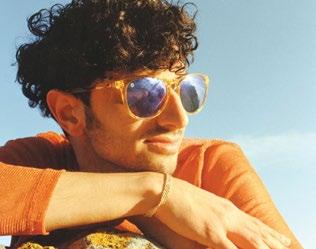
JUSTIN EBRAHEMI
Justin is a San Francisco-based poet and writer whose work surveys the beauty and cumber of Persian American existence. His second poetry collection, ‘Birdsong From Nowruz,’ is available on Amazon.
Instagram: mr.babaaganoush

Instagram: karimipantea
Miguel is a storyteller, father, husband, brother, son, and man of the community who has a passion for capturing sacred moments, freezing time so that it can be relived by anyone who chooses.
Instagram: _MiguelOzuna
ETHAN GREGORY DODGE
Ethan is a freelance journalist based in San Jose. Ethan covers topics ranging from culture to social justice and their intersection with surveillance and policing in the 408.
Twitter: egd_io

KATHERINE HYPES
Katherine is a freelance copyeditor and practitioner of the healing arts. She offers people pockets of rest and rehabilitation through Yin yoga, Restorative yoga and Yoga Nidra. She finds much freedom and play within the world of words and sound ~ check out her meditations on Insight Timer.
Instagram: katherinehypes

TROY EWERS
Troy is a writer and creator with a unique voice and passion for storytelling. Raised in the Southside of San Jose, Troy has worked in music, sports, and fashion for almost a decade now and wants to promote more originality and creativity in art.
Instagram: trizzyebaby
The City of San José Arts Commission and Office of Cultural Affairs are pleased to announce the recipients for the 2023 Cornerstone of the Arts Award!
October 19, 2023
5:30pm – 8:00pm
Hammer Theatre Center
RVSP for the event at:
Let’s Look at Art, a program of the
Cornerstone of the Arts Honoree: Creative Impact Honoree: Community-Based Organization/ Business Support for the Arts Award Honoree:
Congratulations to the recipients for this year’s Cornerstone of the Arts!

 Connie Martinez, Chief Executive Officer of SVCreates
San José Museum of Art
The David and Lucile Packard Foundation
Connie Martinez, Chief Executive Officer of SVCreates
San José Museum of Art
The David and Lucile Packard Foundation
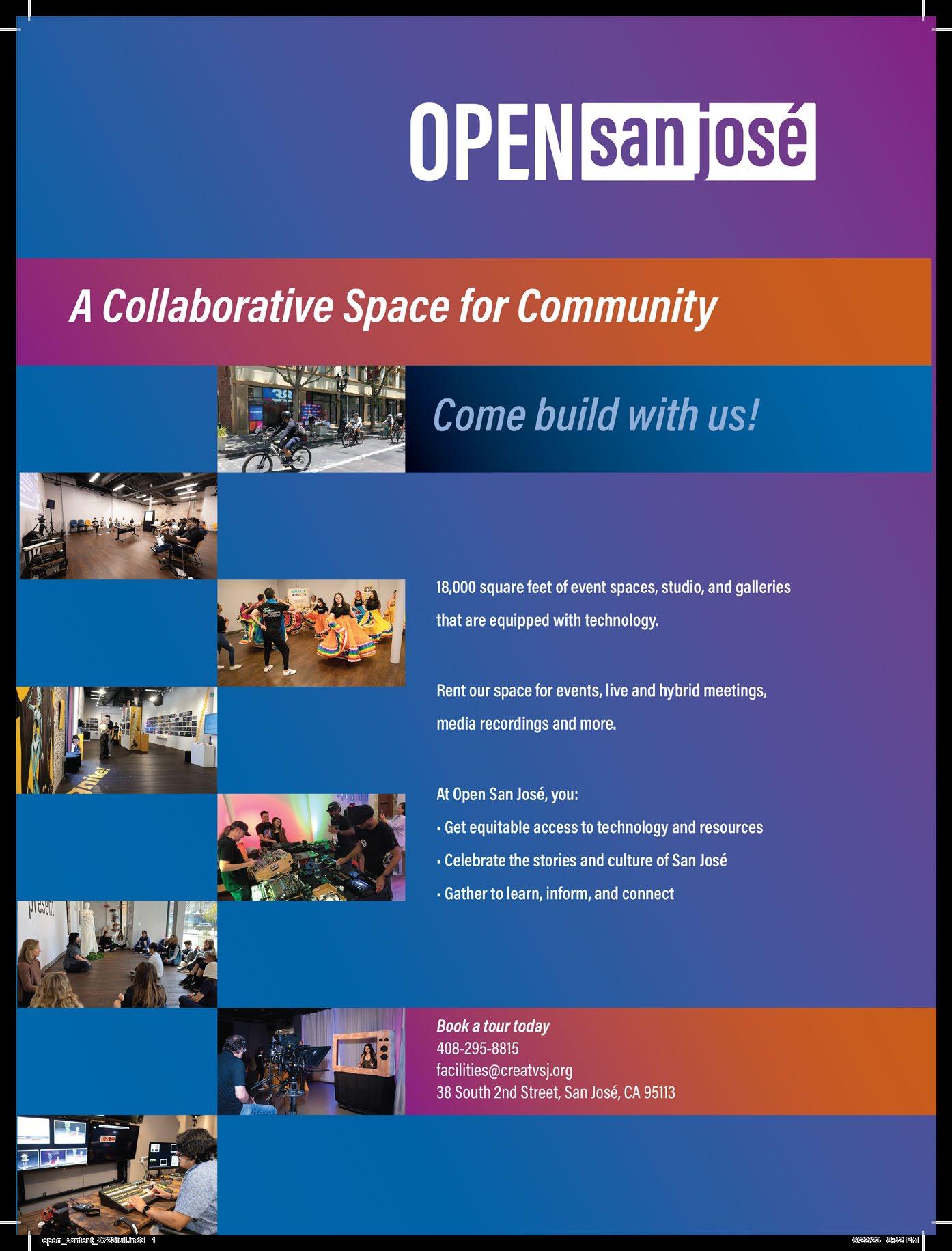


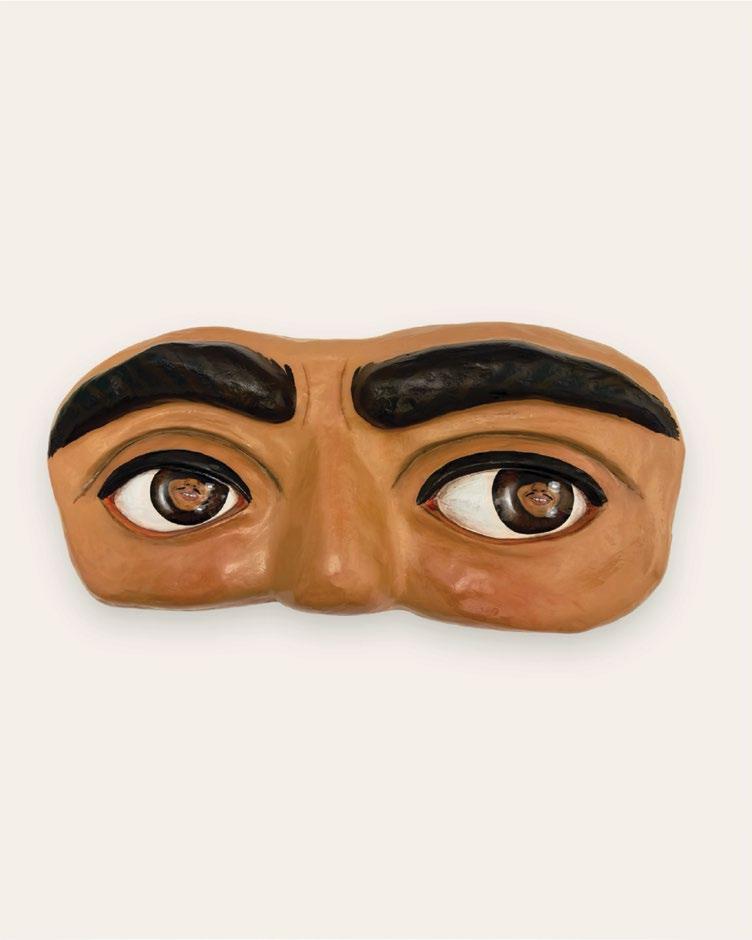



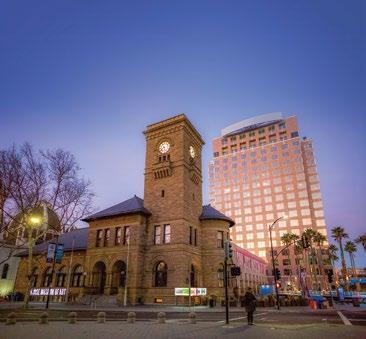







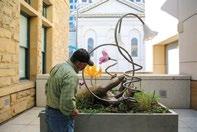






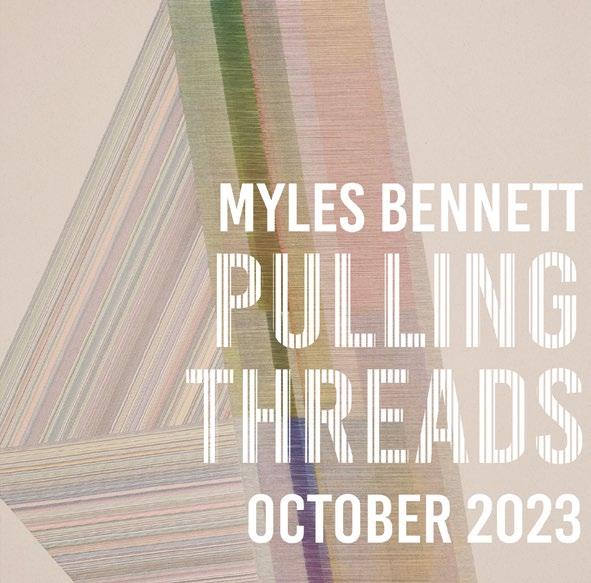




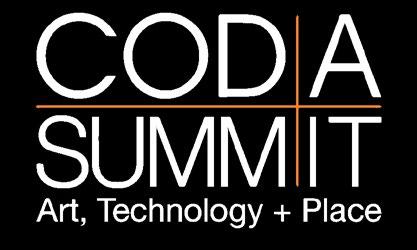


San José’s chic three-story venue offers breathtaking views for your next social event, photoshoot or business meeting
Blanco, an Urban Venue, is the Bay Area’s premier event space in historic downtown San José. This charming building was brilliantly transformed into a three-story, 8,000-square-foot venue by local real estate developer, Mike Messinger, and his wife, Interior Designer, Danielle Messinger. They cleverly maintained the allure of this historic building by refurbishing some of its original features, like its 150-year-old brick walls while adding modern elements with a stunning chandelier, rooftop fireplace and quaint bistro lighting.
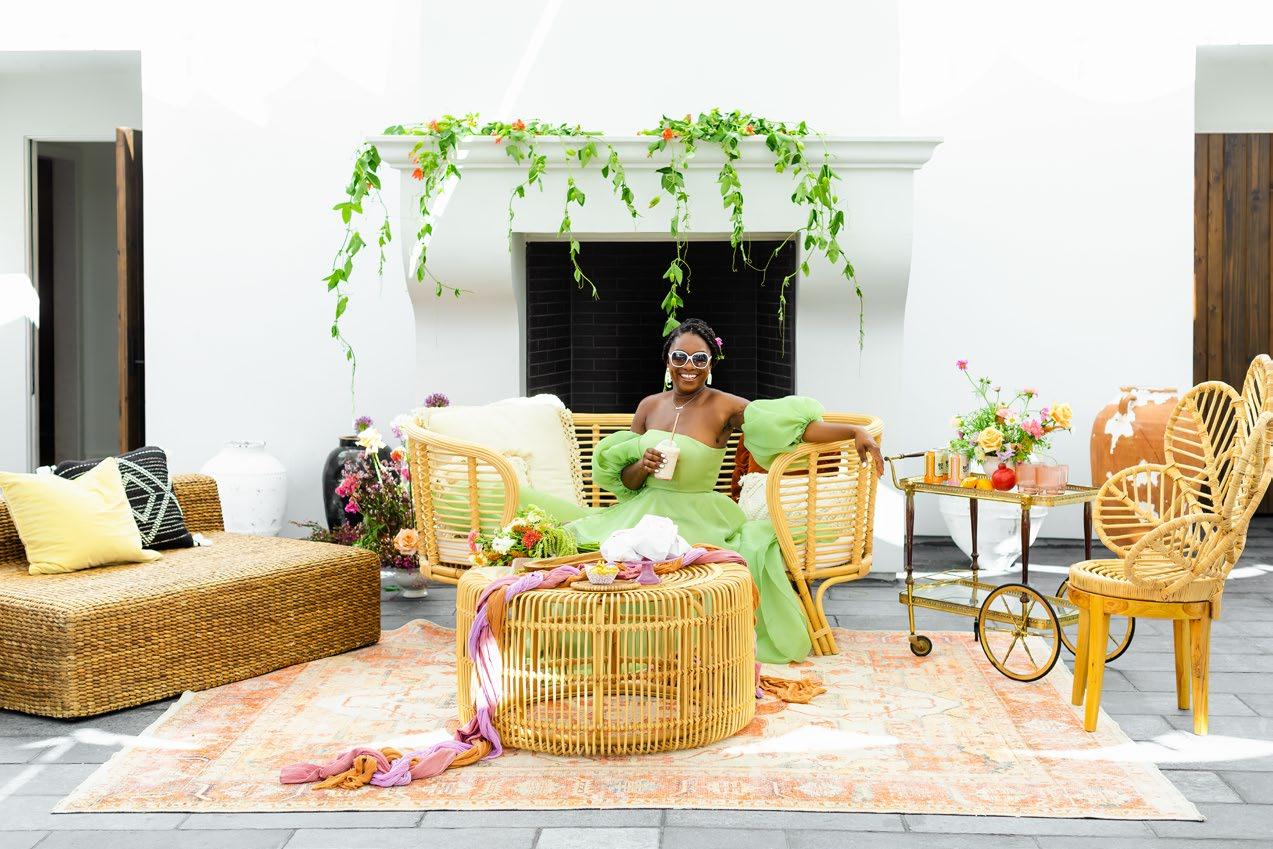
The versatility of Blanco’s indoor and outdoor spaces work seamlessly for larger events, yet allow for smaller gatherings to feel cozy and connected. This blank canvas is a perfect venue for event planners looking to test the boundaries of experimental design, or change up the typical boardroom setting for business meetings. Blanco is conveniently located in the heart of the Silicon Valley near San José International Airport, hotels, restaurants and museums.

PRESENTING THE ARTS & ECONOMIC PROSPERITY 6 REPORT
FRIDAY, NOVEMBER 3
Conducted every five years by Americans for the Arts, Arts & Economic Prosperity is an economic impact study of the nation’s nonprofit arts and culture industry. It is the largest and most inclusive study of its kind ever conducted, with a specific focus on 394 participating communities from across all 50 states plus the District of Columbia. On Friday, November 3, the Office of Cultural Affairs of San José and SVCREATES will unveil the results of Arts & Economic Prosperity 6, including specific data which demonstrates the economic impact of the nonprofit arts industry in San José and Santa Clara Counties.
For an invitation to the leadership luncheon or to receive a copy of the report, please email Alexandra@svcreates.org




Creativity is all about living outside the box, while traditional banking is not. That’s where Tech CU comes in. We’re a different world of banking because we’re a not-for-profit dedicated to providing exceptional service, low loan rates, and superior savings rates. So you can keep breaking the mold.

Discover Tech CU’s Many Ways to Bank
Connect through Virtual Branch Bank on your phone Go online
Use one of 65k fee-free ATMs
Visit a branch Go to techcu.com and become a valued member today!

